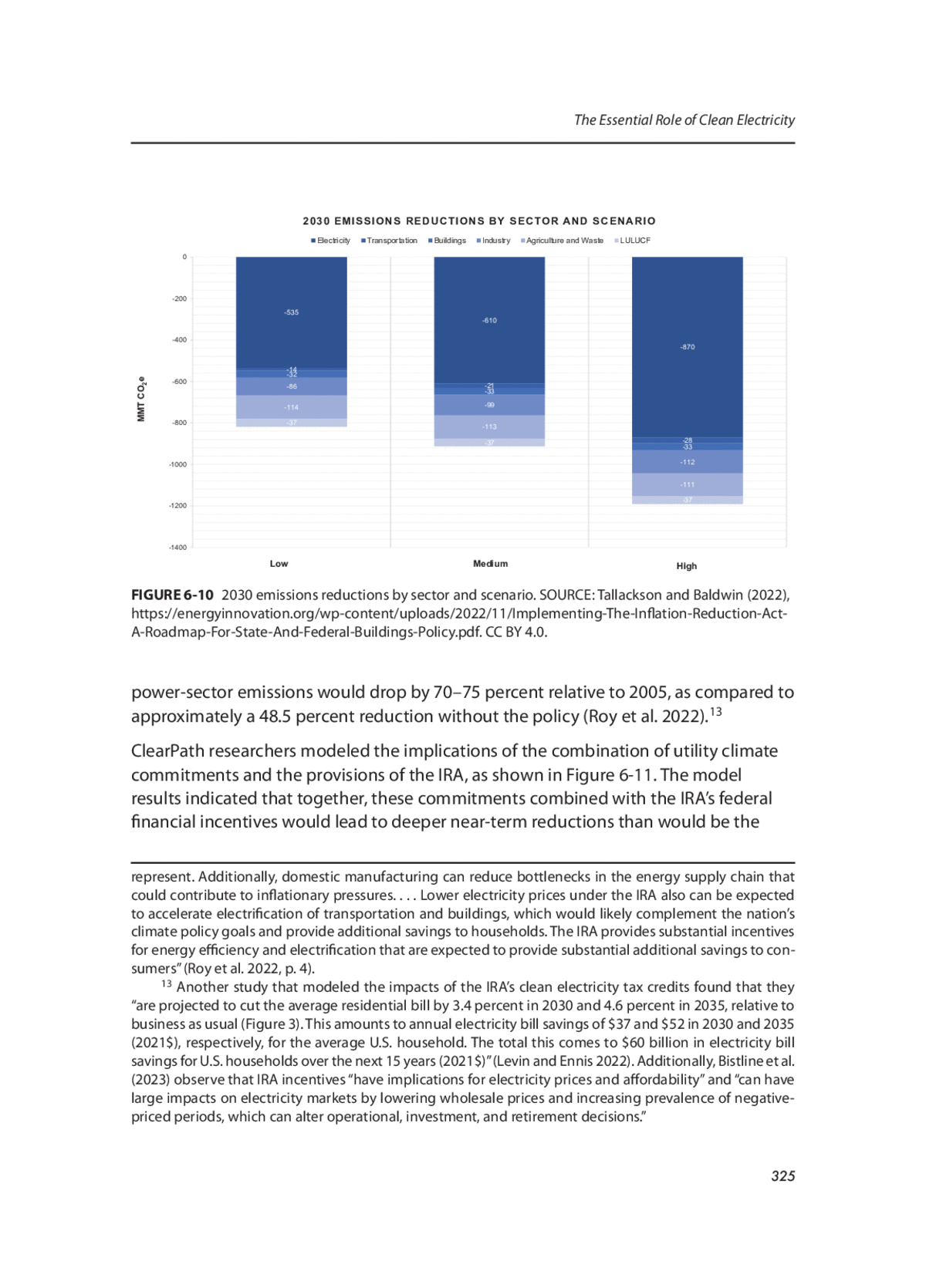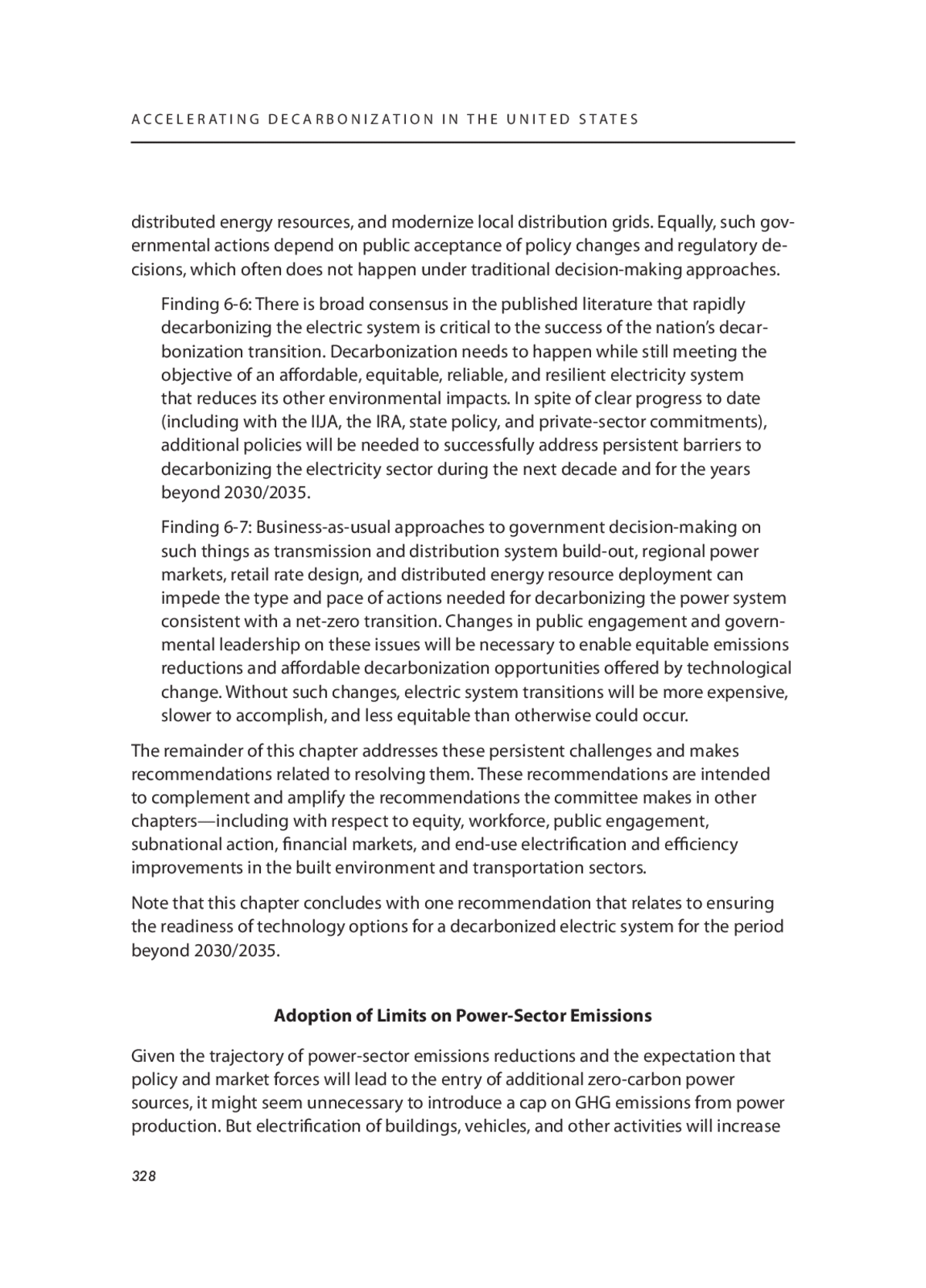6
The Essential Role of Clean Electricity
ABSTRACT
Reducing and eventually eliminating greenhouse gas (GHG) emissions from power generation is essential to reducing overall GHG emissions in the U.S. energy system. Power-sector emissions are currently the second-highest source of emissions. Equally important, electrification of buildings’, vehicles’, and other uses of energy can support decarbonization only if their supply of electricity contributes no net carbon emissions. Recent federal legislation and executive branch action, combined with policy support by many state governments, commitments by private companies, and favorable energy market and technology conditions, are helping to put the U.S. electric system on track to eliminate power-sector GHG emissions by midcentury, if not a decade earlier.
Although further developments are needed for ensuring post-2030 commercial readiness and availability of net-zero carbon generating and storage technologies that provide dispatchable, around-the-clock capabilities, significant and tenacious challenges remain in many non-technical factors necessary to staying on track.
These latter challenges for actors in federal agencies, state and local governments, the private sector, and civil society include
- Public engagement and decision-making support for siting the new transmission facilities and other electric projects and for the expansion of regional wholesale markets necessary to support an electric system that depends increasingly on renewable energy and other carbon-free resources;
- Regulatory support for investment in distribution-system infrastructure and communications, controls, interconnection policies, and other technologies necessary for supporting much-more expanded distributed energy resources at the grid edge;
- Regulatory support for innovative pricing of electricity, utility business model changes, and the provision of related retail services to enable dynamic interactions between customer-sited technologies and equipment and grid operations;
- Support from leaders, boards and stakeholders for the organizational, behavioral, and cultural changes needed in the electric sector;
- Regional coordination of transition planning in the electricity sector with other critical infrastructure sectors and effective engagement with diverse stakeholders and publics around equity and innovation in electricity systems; and
- Policy makers’ support for ensuring that low-income electricity consumers and disadvantaged communities get access to clean and affordable electricity, energy bill savings, and reliable power.
In addition to continued investment of federal funds in research on and development of advanced technologies, greater attention to these non-technological issues is essential for the electric-system transitions needed for affordable, reliable, and equitable decarbonization outcomes.
Other chapters address the important changes that need to occur in the built environment, transportation, and industrial sectors as they rely increasingly on electrical energy, and in public engagement and financial systems to support these transitions.
INTRODUCTION
Clean electricity is essential to decarbonizing the U.S. economy. The many chapters of this report—along with the committee’s first report (NASEM 2021a)—highlight the role that electrification will play in an affordable and effective path toward a net-zero economy. Increased electrification of vehicles, buildings, and industrial processes will be a fundamental element of achieving net-zero GHG emissions by 2050. But if the electricity powering these sectors does not come from net-zero carbon-emitting sources, this approach will not succeed. This chapter addresses issues on the way to a net-zero electricity system, focusing on the supply and delivery of clean power.1 Table 6-1, at the end of the chapter, summarizes all the recommendations that appear in this chapter to support decarbonizing the electricity system.
___________________
1 It is common for discussions of methods to reduce emissions from the power sector to focus on the role of avoiding emissions through such things as energy efficiency and other demand-side measures. Such actions are essential to a decarbonized economy and are discussed in the chapters on end uses of energy (i.e., Chapter 7 on the Built Environment, Chapter 9 on Transport, and Chapter 10 on Industrial Decarbonization) rather than in this chapter on the electric system itself.
The committee’s first report included several recommendations to promote and facilitate a low-carbon electricity system, with particular attention to federal action:2
- Double the share of electricity generated by non-carbon-emitting sources, through
- Setting a clean energy standard for electricity generation designed to reach 75 percent clean electricity by 2030 and net-zero emissions by 2050.
- Expanding wind and solar capacity so that it would supply 45–55 percent of electricity nationwide.
- Retiring coal plants (or retrofitting them to capture more than 90 percent of CO2 emissions).
- Preserving all safely operating existing nuclear power plants.
- Maintaining existing gas-fired capacity (with modest reductions in new capacity).
- Increasing electric transmission capacity by 40 percent to open up access to regions with strong renewable resources and deliver that power to distant regions of the United States.
- Conducting research, development, and demonstration for long-duration energy storage technologies and on advanced electric generation technologies capable of providing around-the-clock power supply with no carbon emissions.
- Reinforcing local electricity distribution networks to accommodate increasing peak demand from electric vehicles, heat pumps, and other new loads.
- Adopting several new authorities to enable the Federal Energy Regulatory Commission (FERC) and the Department of Energy (DOE) to improve the design and functioning of wholesale markets and expansion of electric transmission.3
___________________
2 Additional recommendations to support the electrification necessary for decarbonization and a just transition can be viewed in NASEM (2021c). These recommendations can be filtered, with terms most-relevant to clean electricity including “Produce carbon free electricity”; “Electrify energy services in transportation, buildings, and industry”; “Invest in energy efficiency and productivity”; and “Plan, permit, and build critical infrastructure.”
3 As summarized in Table S.1 in the first report (and repeated in Table C-1 in Appendix C in this publication), the committee’s first report’s recommendations included that
- FERC take the following actions:
- work with regional transmission organizations (RTOs) and independent system operators (ISOs) to ensure that markets in all parts of the country are designed to accommodate the shift to 100 percent clean electricity on the relevant timetable” (p. 199).
-
- Establishing and funding a new national Green Bank to support a wide variety of investments (e.g., in the power sector, buildings, and other eligible project targets).
Recommendations also included financial and technical support for public engagement in infrastructure planning and siting, and for communities and regions that have or will face challenges associated with the energy transition.
The committee made those recommendations in early 2021 with an understanding that the nation’s electricity grid has been undergoing significant change in response to factors beyond the drive to equitably decarbonize the energy system. These other influences include the growth of distributed energy resources and behind-the-meter technology, evolution of the electricity system’s institutional and market structure, new roles for consumers in the electricity system, and growing complexities in operational and electric-system security issues. Although implemented for economic, social, and other reasons, many of these other influences help to drive decarbonization outcomes as well.
___________________
-
- direct [the North American Electricity Reliability Corporation] to establish and implement standards to ensure that grid operators have sufficient flexible resources to maintain operational reliability of electric systems” (p. 199).
- Congress enact the following:
- establish that it is the “National Transmission Policy to rely on the high-voltage transmission system to support the nation’s” goals to achieve net-zero carbon emissions in the power sector (p. 211).
- authorize and direct FERC to require transmission companies and RTOs “to analyze and plan for economically attractive opportunities to build out the interstate electric system to connect regions that are rich in renewable resources with high-demand regions” (p. 211).
- assign to FERC “the responsibility to designate any new National Interest Electric Transmission Corridors and to clarify that it is in the national interest for the United States to achieve net-zero climate goals as part of any such designations” (p. 211).
- authorize FERC to issue certificates of public need and convenience for interstate transmission lines (along the lines now in place for certification of gas pipelines), with clear direction to FERC that it should consider the location of renewable and other resources to support climate-mitigation objectives, as well as community impacts and state policies as part of the need determination (i.e., in addition to cost and reliability issues) and that FERC should broadly allocate the costs of transmission enhancements designed to expand regional energy systems in support of decarbonizing the electric system” (p. 211).
- clarify that the Federal Power Act does not limit the ability of states to use policies (e.g., long-term contracting with zero-carbon resources procured through market-based mechanisms) to support entry of zero-carbon resources into electric utility portfolios and wholesale power markets . . . [and] direct FERC to exercise its rate-making authority over wholesale prices in ways that accommodate state action to shape the timing and character of the transitions in their electric resource mixes” (p. 199).
Finding 6-1: The transition to a net-zero power supply must occur alongside progress on other needs for the electric system—that is, that electricity supply is affordable, safe, secure, sustainable, equitable, and resilient (NASEM 2021b)—all of which pose challenges of their own and complicate the challenge of decarbonization.
DEVELOPMENTS SINCE EARLY 2021
A lot has happened since the committee issued its first report in February 2021. Changes have occurred in energy markets, in federal policy support for investment in clean power resources, and in subnational-government and private-sector actions.
Market Conditions
Although the U.S. economy overall remains highly dependent on fossil fuels (with coal, oil, and natural gas providing nearly four-fifths of all primary energy consumption [Chapter 12]), the electricity sector’s reliance on fossil fuels continues to decline, with nuclear, hydro, wind, solar, and other zero-carbon energy sources accounting for 41 percent of total power supply (Rivera et al. 2023). In fact, virtually all of the zero-carbon energy used anywhere in the U.S. economy was used to produce electricity.
With increases in wind and solar capacity additions (EIA 2022a), renewable resources have accounted for a steadily growing share of power supply and are expected to account for 22 percent of electricity in 2022 (EIA 2022a), with much of those renewables occurring in the West, Southwest, and Plains states, where there is high renewable resource potential. Over the past decade, wind generation grew by 2.7 times, and solar photovoltaic generation at utility-scale and behind-the-meter sources increased from a minimal amount in 2012 to 160,799 GWh in 2021 (EIA 2022b). Coal-fired electricity generation has declined and now accounts for one-fifth of the nation’s electricity, after decades during which it accounted for half of the country’s power supply.4 Power sector CO2 emissions dropped by over one-third from 2005 through the end of 2022, with emissions slightly increasing from 2020 through 2022 (EIA 2023).
Based on analyses that incorporate the impacts of recent federal legislation, the Congressional Budget Office (CBO) anticipates that over the upcoming decade,
___________________
4 Coal-fired generation provided between 45 percent to 57 percent of U.S. electricity for the period from 1950 to 2010, with most years having higher than 50 percent. Since then, coal-fired power production decreased gradually as gas-fired and renewable generation have increased and power demand has remained relatively flat. EIA (2023, Tables 7.2a and 7.2b), https://www.eia.gov/electricity/data.php#generation.
power-sector CO2 emissions can be expected to decrease further, largely because of the introduction of new wind and solar projects and with the pace and magnitude of reductions depending on changes in costs of wind, solar and battery technologies, fossil fuel prices, and the siting of new renewable projects and transmission lines (CBO 2022).
Finding 6-2: Total power-sector CO2 emissions dropped by 36 percent between 2005 and 2022, and the carbon intensity of electric supply dropped 42 percent since 2005.5 While progress has slowed in recent years, reductions are expected to accelerate again in upcoming years.
Federal Policy
Progress ahead is anticipated in light of several major federal actions adopted in the executive branch and in Congress since early 2021.
Executive Branch Action
In the earliest days of his administration, President Biden issued multiple executive orders (EOs) committing to put “the climate crisis at the center of United States foreign policy and national security,” take “a government-wide approach to the climate crisis,” use “the federal government’s buying power and real property and asset management” to advance a clean energy transition, empower “workers through rebuilding our infrastructure for a sustainable economy,” and secure environmental justice and economic opportunity (White House 2021a). The President announced that the United States would rejoin the Paris Agreement.
In March 2021, President Biden proposed a $2 trillion infrastructure plan, including hundreds of billions of investment dollars for the electric grid and clean energy and climate technology (Parlapiano and Tankersley 2021). By April 2021, the President had set a goal of reaching 100 percent clean electricity by 2035 (White House 2021c). On the eve of the United States’ participation in the United Nations Framework Convention on Climate Change’s (UNFCCC’s) Conference of the Parties (COP26) in Glasgow, Scotland, in late 2021, the President announced the climate components of his proposed “Build Back Better” framework, including tax credits, grants, loans, and other incentives for clean energy investment (including in the power sector), and consumer rebates and tax credits to help families shift to electric equipment and install energy efficiency measures (White House 2021b).
___________________
5 Carbon intensity (pounds of CO2 per MWh), as of Q2 2022 (Samaras 2022).
Agency actions further supported the clean power agenda. In the summer of 2021, FERC asked for comments on what changes were needed in interstate transmission planning and cost support in order to plan more holistically for the nation’s needs as the electric system shifted to greater reliance on renewable resources often located far from consumers (FERC 2021). In April 2022, FERC proposed new regulations to modify its transmission planning, cost-allocation, and generator interconnection policies so as to address “some perceived shortcomings in current regional transmission planning processes” and its ability to keep pace with changing electric-system needs (FERC 2022b).
In the month prior to FERC’s issuance of its proposed transmission-planning rule, the Securities and Exchange Commission (SEC) proposed rules to enhance publicly traded companies’ disclosure of climate-related risks and GHG emissions (SEC 2022). This was important for the power sector in light of the large number of electric companies that had made commitments to reduce GHG emissions, and the role that transparency and reporting plays in maintaining corporate commitment to decarbonization. (See Chapter 11 for further discussion.)
Power-plant emissions regulation by the Environmental Protection Agency (EPA) was addressed by the Supreme Court in its June 2022 decision in the West Virginia v. U.S. EPA case, which held that without a clear statement of congressional intent that delegated authority to an agency for certain “major” regulations, the agency was limited in adopting and implementing regulations in that domain (Bergman et al. 2022; RFF 2022; Supreme Court of the United States 2021). In May 2023, EPA issued new proposed standards for regulating CO2 emissions from new and existing fossil-fueled power plants, with EPA analyses indicating that the proposal would avoid 617 million metric tons of CO2 through 2042 and that the reduced air pollutants would lead to up to $85 billion in climate and public health benefits over the next 2 decades (EPA 2023). Complying with these proposed standards would require emissions-control through carbon capture and storage/sequestration (CCS), or co-firing coal plants with natural gas and co-firing natural gas plants with low-emissions hydrogen (Lashof 2023). Enacting these emissions-control strategies will require testing and adaptation by the power sector, which could influence the electricity system’s trajectory along its energy transition pathway.
Congressional Action
The President’s proposals and commitments ultimately found their way into two congressional laws: the Infrastructure Investment and Jobs Act (IIJA) enacted in late 2021 and the Inflation Reduction Act (IRA) of August 2022. Although neither law included a
binding target for reducing total CO2 or GHG emissions in either the power sector or the economy at large, both laws provided billions of dollars of incentives to encourage clean energy investment and project development to enter the market over the upcoming decade.
Power-Sector Provisions of the IIJA
The IIJA authorizes more than $50 billion for clean energy for the power sector (and other large-scale facilities), grid hardening and resilience, retention of existing nuclear and hydropower facilities, and building out the nation’s electric grid (McLaughlin and Bird 2021). Figure 6-1 shows funding amounts for relevant sections (not counting the support for electrifying transportation [shown in the yellow rectangle] and reducing energy costs and improving efficiency [shown in the dark green rectangle]):
- Support the clean energy economy and innovation (shown in the dark orange rectangle): $28 billion
- Carbon capture and storage for industrial and power-sector purposes: $10 billion
- Battery supply chains used in energy storage and electric vehicle (EV) applications: $7 billion

SOURCE: McLaughlin and Bird (2021), https://www.wri.org/insights/implementing-clean-energy-investments-us-bipartisan-infrastructure-law. CC BY 4.0.
-
- Hydrogen hubs, electrolysis cost reduction, and recycling: $8 billion
- Advanced modular nuclear reactors: $3 billion
- Support grid hardening and resilience (shown in the blue rectangle): $11 billion
- Grid reliability and resilience research and development: $6 billion
- Competitive grants for grid hardening and weatherization: $5 billion
- Retain existing nuclear and hydro generation (shown in the light green rectangle): $6.7 billion
- New civil nuclear credit program to retain existing nuclear fleet: $6 billion
- Retain efficiency and improve operations of existing hydropower facilities: $0.7 billion
- Build the transmission system (shown in the purple rectangle): $5.5 billion
- Expansion of the Smart Grid Investment Matching Grant Program: $3 billion
- Revolving loan fund to support nationally significant transmission lines: $2.5 billion.
In August 2022, DOE established a new Grid Deployment office to lead the $17 billion in IIJA programs and projects related to the nation’s electric transmission, distribution, and power generation needs, as well as the programs to retain carbon-free power from nuclear and hydroelectric facilities (DOE 2022). The IIJA also included a requirement that state utility regulators consider establishing electricity rate mechanisms that allow utilities to recover the costs of promoting customer demand-response practices (BIL Summary 2021). Such flexible demand has the potential to help grid managers operate a grid reliably and economically with greater penetration of intermittent resources like solar and wind generation (NASEM 2021b).
Power-Sector Provisions of the IRA
Although President Biden and many congressional leaders had hoped to see greater financial incentives for clean power in 2021, it was not until August 2022 that such incentives were put into law through the IRA. Considered the largest climate bill ever enacted by Congress, the IRA includes numerous additional incentives for a low-carbon electric system on top of those in the IIJA.
For example, the IRA increases DOE’s lending and loan-guarantee authority for power-system and other energy infrastructure;6 authorizes $27 billion in funding for state,
___________________
6 The Bipartisan Policy Center (BPC) observes that the IRA gave the DOE Loan Programs Office “$40b in new Title 17 loan authority available through 2026 with $3.6 billion for credit subsidies” and creates the Energy Infrastructure Reinvestment Financing program with “$5 billion to carry out program authorities and $250 billion in loan authority through 2026” (BPC 2022a, p. 17).
local, tribal, and nonprofit financial institutions to invest in equitable access to clean energy through a new Greenhouse Gas Reduction Fund (§60103) under authority given to EPA; and provides significant tax-credit incentives for private investment in clean energy. As described by analysts from the Rhodium Group in their analysis of IRA impacts, the new law includes a suite of long-term, full-value, flexible clean energy tax credits and other programs in the IRA focus on the “4 Rs” of electric generation decarbonization:
- Reinvigorate new clean capacity additions: production and investment tax credits (PTC and ITC);
- Retain existing clean capacity: zero-emitting nuclear PTC;
- Retire fossil capacity: U.S. Department of Agriculture (USDA) investments in rural electric cooperatives (coops) and [DOE] loan programs; and
- Retrofit remaining fossil capacity: section 45Q carbon capture tax credit (Larsen et al. 2022, p. 4).
More specifically, the production and investment tax credits (e.g., for clean hydrogen production, for renewable power investment and/or electrical output, for new advanced manufacturing for clean energy equipment components) either extend existing ones that are slated to expire or add new ones available to investors over the next decade. Many of the tax credits include direct pay provisions (in lieu of a tax credit) that open up greater investment opportunities for tax-exempt entities (e.g., electric coops) and enable efficient use of federal incentives (BPC 2022b). Legal analysts (Eversheds Sutherland 2022; Schurle et al. 2022; Sidely 2022) have pointed to other notable changes in the IRA’s clean-energy tax credits, including providing bonus credits where facilities are constructed on brownfield sites or in an area where there have been closures of coal mines or coal-fired generating facilities; tying full availability of the credit value to such things as near-term commencement of construction and prevailing wage and apprenticeship requirements; relying on product inputs (e.g., steel, iron, other manufactured products) produced in the United States. The Department of the Treasury plays an important role in specifying and clarifying these tax credit provisions and qualifications.
Subnational Government Policy
Meanwhile, states and localities have also taken steps to lower power-sector emissions. Most states have some sort of mandate to add increasing amounts of renewable energy to their electricity supply, and many states have further requirements to significantly reduce or eventually eliminate electricity sources with GHG emissions in the decades ahead (Figure 6-2). Notably, states accounting for more than 50 percent of the nation’s
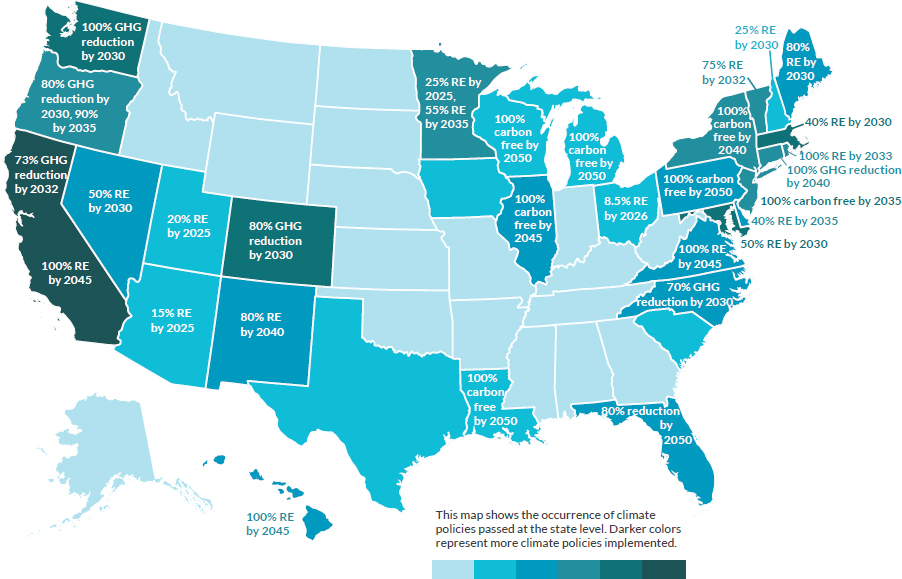
power demand have adopted clean-power goals (EIA 2021).7 These actions by states provide additional heft in the nation’s push toward decarbonizing the power system.
Private-Sector Commitments
Many other public and many private entities have also made substantial climate commitments affecting clean-power transitions. As of 2019, subnational and private-sector entities representing 71 percent of U.S. Gross Domestic Product (GDP), 68 percent of the population, and 51 percent of GHG emissions had pledged to reduce GHG emissions (see Figure 6-3). The federal statutory support from the IIJA and the IRA can be expected to strengthen the chances that these emissions reductions will occur
___________________
7 These states include California, Colorado, Connecticut, Florida, Hawaii, Illinois, Louisiana, Maryland, Massachusetts, Michigan, Minnesota, Nevada, New Jersey, New Mexico, New York, North Carolina, Oregon, Pennsylvania, Virginia, and Washington.

through private-sector commitments and do so earlier and at lower cost than without the new federal financial incentives in place.
Notably, electric utilities serving 84 percent of the nation’s electricity customer accounts have made commitments to have either 100 percent renewable/clean power or net-zero emissions by no later than 2050 (Figure 6-4). In all, 497 individual utilities are preparing to meet their state’s 100 percent carbon-reduction mandates (SEPA 2023).
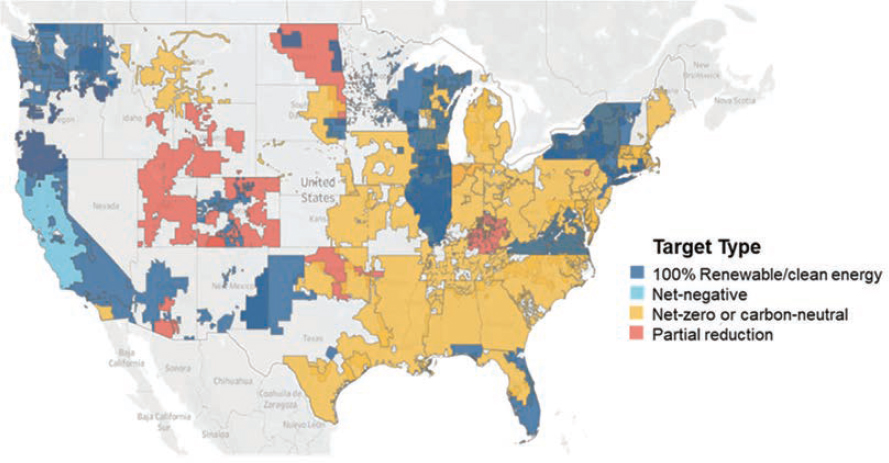
Power-sector actions emerging from these subnational-government and private-sector commitments include investment in and contractual procurements of onshore and offshore wind, and utility-scale and distributed solar capacity (MA Department of Public Utilities 2017; McGovern 2022; Penrod 2022; Peretzman 2022); retirements of coal plant capacity (Brown 2022); programs to compensate zero-carbon generating resources (like existing nuclear plants) for their value in avoiding carbon emissions (Illinois Power Agency 2021; Lopez 2022; Trabish 2021); electric transmission project plans (Grid North Partners 2022; Willson 2022); adopting carbon prices in state electricity markets (McCarthy 2022; RGGI 2023); and corporate efforts (e.g., the 300-member Clean Energy Buyers Alliance8) to accelerate the achievement of carbon-free electricity through procurements of clean energy (CEBA 2023). Figure 6-5 depicts carbon-reduction targets by utility companies compared to state requirements.
Finding 6-3: A significant share of actors with decision-making responsibility for power-sector developments has made climate commitments. States accounting for more than 50 percent of the nation’s power demand have adopted clean-power goals. Subnational and private-sector entities representing
___________________
8 Since 2014, “energy customers have voluntarily procured over 60 gigawatts (GW) of clean energy,” which is “equivalent to 26 percent of the total capacity added to the U.S. grid 2014–2022” and includes “16.9 GW of new clean energy deals announced by energy customers in 2022” CEBA (2023).
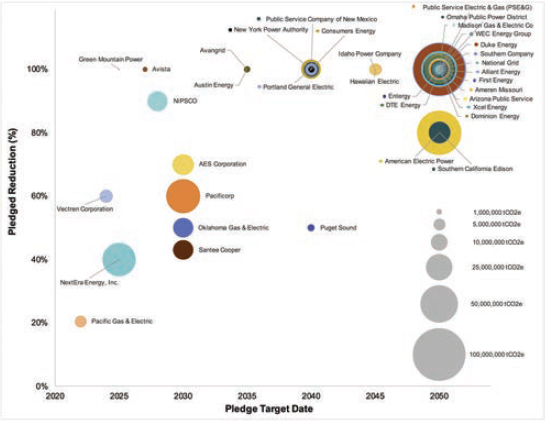
71 percent of U.S. GDP, 68 percent of the population, and 51 percent of GHG emissions have pledged to reduce GHG emissions. Electric utilities representing 84 percent of the nation’s electricity customer accounts have made commitments to have either 100 percent renewable/clean power or net-zero emissions by no later than 2050. The federal support from the IIJA and the IRA can be expected to strengthen the chances that these emissions reductions will occur and do so earlier and at lower cost than without the new federal financial incentives in place.
HOW FAR DO CURRENT/NEW POLICY AND MARKET CONDITIONS GET US?
From a technology-deployment and investment point of view, the types of clean-power incentives and commitments taking shape in recent years align with the recommendations offered by the committee in its first report, which indicated that non-carbon-emitting sources of power would need to account for 75 percent of the electric power supply by 2030 to put the nation on a path to net zero by midcentury. (Figure 1-3 in Chapter 1 indicates that such a trajectory of emissions reductions is consistent with the White House’s Long-Term Strategy and its outlook for the power sector [DOS and EOP 2021].)
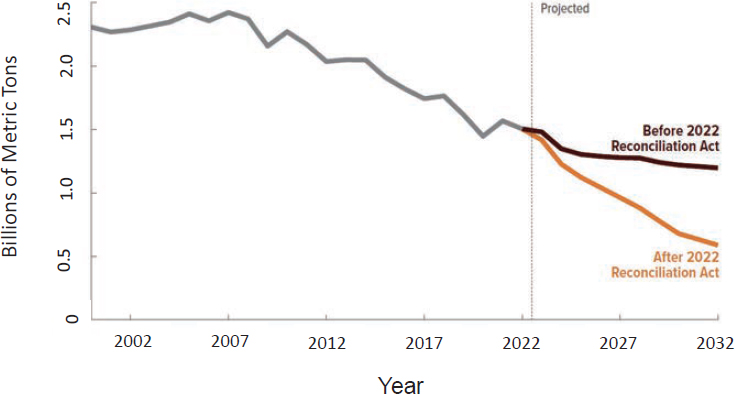
Early reporting on (Ewing and Penn 2022) and estimates of (CBO 2022; Jenkins et al. 2022b; Larsen et al. 2022; Mahajan et al. 2022) the impacts of these federal, state, local, and private efforts show that they will help to make important progress toward decarbonizing the electric system.
For example, CBO has estimated that the IRA (also known as the 2022 Reconciliation Act) alone could lead to significant carbon emission reductions in the power sector over the next decade (as shown in Figure 6-6), with potential uncertainty related to factors such as the cost of new wind, solar, and battery capacity; future fossil fuel prices; and the availability of transmission expansion potentially leading to higher or lower emissions levels by 2032 (CBO 2022).
The REPEAT modeling team (Jenkins et al. 2022b) estimates that the combination of IIJA and IRA provisions and other existing federal and state policy is likely to accelerate progress toward the goal of zero-emitting resources accounting for 75 percent of power supply by 2030. By substantially reducing investors’, owners’, and consumers’ cost of adding and maintaining zero-emitting generation technologies, the IRA’s tax-credit provisions, for example,
could spur record-setting growth in wind and solar capacity, with annual additions increasing from 15 GW of wind and 10 GW of utility-scale solar PV in 2020 to an average of 39 GW/year of wind additions in 2025–2026 (~2× the 2020 pace) and 49 GW/year of solar (~5× the 2020 pace), with solar growth rates increasing thereafter. The bill will also incentivize deployment of carbon capture at new and existing natural gas power plants and retrofits of existing coal plants, owing to the enhanced 45Q tax credit. (Jenkins et al. 2022b, p. 11)
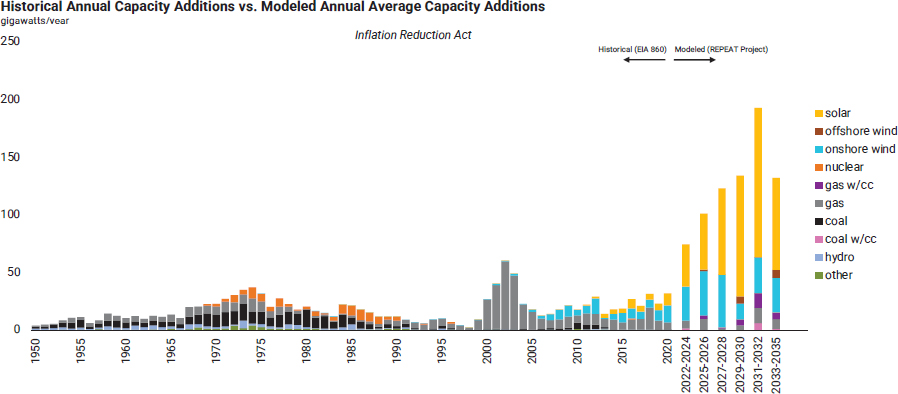
Figure 6-7 shows the projected annual increases in solar, onshore wind, and offshore wind capacity additions that REPEAT estimates could enter the system after 2022.9
The REPEAT Project examined the sensitivity of different carbon-reduction outcomes in the power sector to changes in assumptions about the pace of build-out of the nation’s high-voltage transmission grid. Zero-emitting resources would accelerate and expand so as to contribute from approximately 50 percent to 80 percent of power supply by 2030 and between 60 percent and 85 percent by 2035 (see Figure 6-8). The availability of increased transmission would allow for faster reductions in fossil generation and their GHG emissions.
In April 2023, Jenkins et al. previewed a revised analysis, which reflected supply chain and other limiting constraints slowing policy implementation, estimating the
___________________
9 The REPEAT project authors add the following caveat to this analysis: “Several constraints that are difficult to model may limit these growth rates in practice, including the ability to site and permit projects at requisite pace and scale, expand electricity transmission and CO2 transport and storage to accommodate new generating capacity, and hire and train the expanded energy workforce to build these projects. Modeled results should thus be taken as indicative that IRA establishes strong financial incentives to build capacity at the modeled pace, while non-financial challenges may constrain the pace of real-world deployment relative to modeled results. Several policies in IRA and the Bipartisan Infrastructure Law, as well as proposed permitting reforms to be considered by Congress this Fall, can reduce these non-financial barriers (e.g., reforms to transmission siting and funding for CO2 transport and storage in IIJA; funding to expedite NEPA review in IRA; transmission investment funding in both bills)” (Jenkins et al. 2022, p. 11).
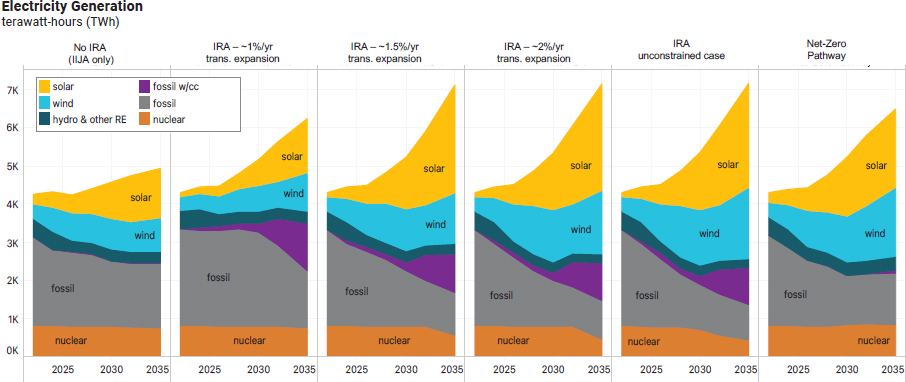
SOURCE: Jenkins et al. (2022a), https://doi.org/10.5281/zenodo.7106176. CC BY 4.0.
IRA’s effects to result in approximately 37–41 percent of emissions reductions below 2005 levels, compared with approximately 43 percent in the preliminary analysis (Jenkins et al. 2023).
Estimates by several other analytic teams—Rhodium Group, Resources for the Future (RFF), the National Renewable Energy Laboratory (NREL), Energy Innovation, and ClearPath—reach similar conclusions about the impact of new federal policy on changes in the power sector. Figure 6-9 summarizes the results of power-sector estimates of clean generation shares in 2030 as conducted by the Rhodium Group (Larsen et al. 2022); Figure 6-10 shows Energy Innovation’s range of estimates of 2030 GHG emission reductions associated with investments and operations, with most of the reductions occurring in the electricity sector (Mahajan et al. 2022).
Analysis by the NREL team indicates that shares of clean electricity10 would increase from 41 percent in 2022 to 71–90 percent of total generation by 2030 (a 25–38 percentage point increase relative to a “no new policy” scenario) with the implementation of key provisions from the IRA and the IIJA (also referred to as the Bipartisan Infrastructure Law) (Steinberg et al. 2023). In turn, this modeling indicates that by 2030, annual power sector CO2 would be between 72–91 percent of the 2005 baseline along with a 5–13 percent reduction in average annual bulk power system costs.
___________________
10 Includes nuclear, fossil energy with CCS, wind, solar, hydroelectric, geothermal, landfill gas, and biomass.
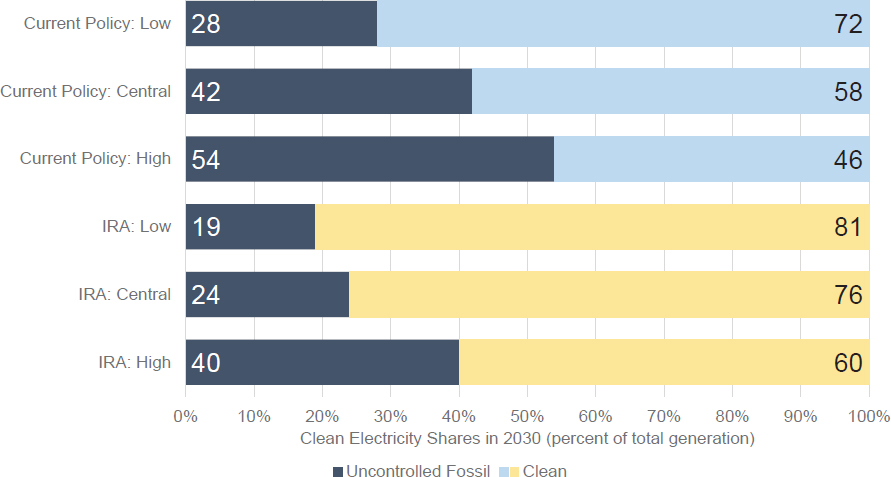
RFF analysts have modeled electric-industry transitions in light of the new federal statutes (and in particular, their tax incentives for clean energy supply) (Roy et al. 2022). Their analysis compared “the average annual change in retail prices in the no-policy baseline and in the policy scenarios under expected natural gas prices, as well as with alternative natural gas price scenarios from [EIA’s] AEO 2021. The IRA is projected to have a deflationary effect on retail electricity prices under all of the alternative scenarios we modeled” (Roy et al. 2022, p. 2).11 The RFF researchers concluded that electricity costs to consumers could be expected to decline 5.2–6.7 percent over the next decade, saving them $209 billion–$278 billion, and smaller electricity bills and lower costs of other goods and services would mean $170–$220 in annual savings to the average household (Roy et al. 2022).12 The RFF analysis estimated that by 2030,
___________________
11 “Even if natural gas prices are higher than expected, as they have been in recent months owing to global shocks in fuel prices, electricity rates are still projected to decline under the legislation” (Roy et al. 2022, p. 3).
12 The study notes other outcomes of the federal legislation, as well. “There are several provisions in the IRA subsidizing the domestic manufacturing and production of inputs to electricity generation that also can contribute to a reduction in the capital costs of qualifying generation, and which our modeling does not
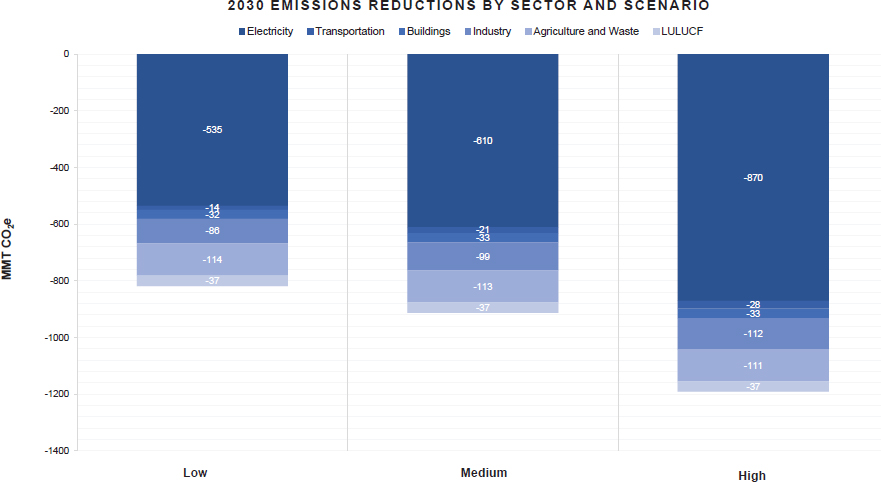
power-sector emissions would drop by 70–75 percent relative to 2005, as compared to approximately a 48.5 percent reduction without the policy (Roy et al. 2022).13
ClearPath researchers modeled the implications of the combination of utility climate commitments and the provisions of the IRA, as shown in Figure 6-11. The model results indicated that together, these commitments combined with the IRA’s federal financial incentives would lead to deeper near-term reductions than would be the
___________________
represent. Additionally, domestic manufacturing can reduce bottlenecks in the energy supply chain that could contribute to inflationary pressures. . . . Lower electricity prices under the IRA also can be expected to accelerate electrification of transportation and buildings, which would likely complement the nation’s climate policy goals and provide additional savings to households. The IRA provides substantial incentives for energy efficiency and electrification that are expected to provide substantial additional savings to consumers” (Roy et al. 2022, p. 4).
13 Another study that modeled the impacts of the IRA’s clean electricity tax credits found that they “are projected to cut the average residential bill by 3.4 percent in 2030 and 4.6 percent in 2035, relative to business as usual (Figure 3). This amounts to annual electricity bill savings of $37 and $52 in 2030 and 2035 (2021$), respectively, for the average U.S. household. The total this comes to $60 billion in electricity bill savings for U.S. households over the next 15 years (2021$)” (Levin and Ennis 2022). Additionally, Bistline et al. (2023) observe that IRA incentives “have implications for electricity prices and affordability” and “can have large impacts on electricity markets by lowering wholesale prices and increasing prevalence of negative-priced periods, which can alter operational, investment, and retirement decisions.”
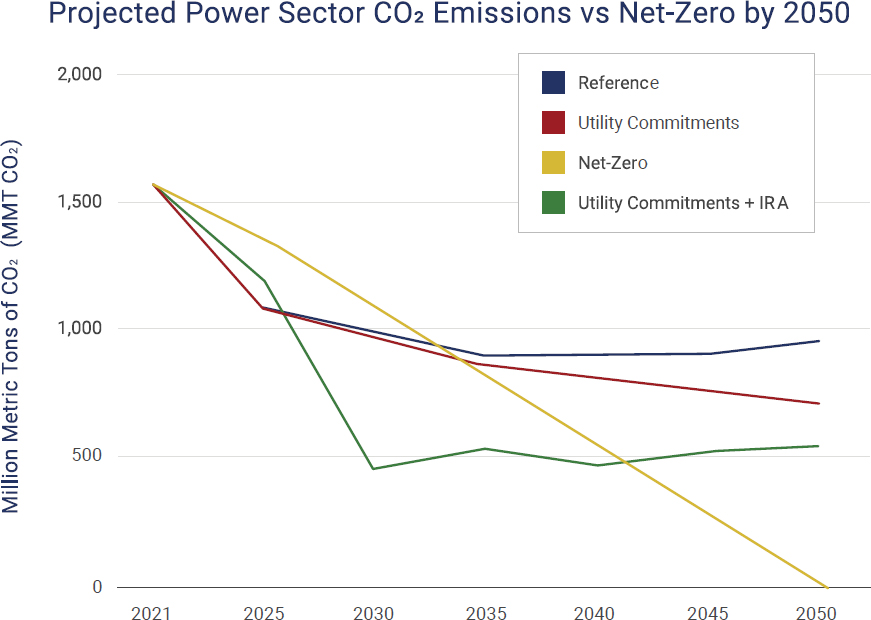
SOURCE: ClearPath (2023).
case with the corporate commitments alone and helped to put the power sector on a trajectory of 2040 emissions close to what is needed to head toward a net-zero pathway as of that year.
A recent nine-model intercomparison published in Science shows the IRA resulting in wind and solar growth rates ranging from 10 to 99 GW/year between 2021 to 2035, with particularly wide variation in predicted increases in energy storage, ranging from 1 to 18 GW/year. Despite this variation, generation and emissions outcomes for the power sector are more closely aligned across models by 2035, with key provisions from the law resulting in emissions reductions of 43 percent and 48 percent below 2005 levels by 2035 (Bistline et al. 2023).
Finding 6-4: From a technology point of view, the combination of new federal policies (e.g., the IIJA and the IRA), state policy adoption, and other subnational and private-sector commitments put the United States on track to reduce power-sector emissions in 2030/2035 by a percentage consistent with achieving net-zero emissions by midcentury.
Finding 6-5: Power-sector clean-energy transitions enabled by recent federal legislation can help to lower electricity bills and produce energy bill savings for consumers.
BARRIERS, IMPEDIMENTS, AND WHAT STILL NEEDS TO BE DONE TO ACHIEVE NET-ZERO POWER SUPPLY
As the committee stated in its first report, “decarbonization studies find that reaching net-zero emissions is technically feasible (and relatively low cost) provided that significant proactive effort is invested over the next decade to drive the maturation and improvement of a range of more nascent technologies and solutions needed to reach net-zero emissions” (NASEM 2021a, pp. 59–60).
The positive outcomes that could result from technically feasible and increasingly economical deployment of clean-power technologies—especially in light of federal financial support introduced by the IIJA and the IRA—depend to a large degree on resolving persistent non-technological challenges. Examples of non-technological issues are institutional and jurisdictional complexities in the power sector—barriers that were summarized by an expert workshop hosted by RFF and that include
market structures that disfavor renewable energy resources, backed-up interconnection queues, local siting opposition, policy uncertainty, and challenges in arranging for efficient procurement of clean power . . . institutional mismatch between state agencies and Regional Transmission Operators (RTOs) with authority over transmission, difficulty agreeing on cost allocation for interstate and interregional transmission, insufficient state government capacity for studying and engaging with the planning process, and local opposition. Demand management is hampered by lack of access to energy efficiency for low-income households and renters, inadequate metrics for energy efficiency, inadequate price incentives for consumers, incomplete incentives for utilities and transmission investors, and inequitable and confusing rate structures. (Domeshek et al. 2022, p. ii)
Many of these same issues were discussed during panels hosted by the committee and in publications, government convenings, and articles of experts in the industry (see, e.g., FERC 2021; NASEM 2021a,b). Chapters 5 and 11 of the committee’s report also discuss new, reformed, and innovative aspects of public engagement and activities of subnational governments as critical to addressing non-technical issues associated with transitions in the power sector.
Many of these challenges relate to the adoption of government policies that were recommended in our first report but not subsequently enacted in the IIJA or the IRA, including a cap on power-sector emissions and/or a clean power standard. Additional policies are still needed to build out the electric grid to accommodate more renewables, expand regional power markets, improve the design of electricity rates, deploy
distributed energy resources, and modernize local distribution grids. Equally, such governmental actions depend on public acceptance of policy changes and regulatory decisions, which often does not happen under traditional decision-making approaches.
Finding 6-6: There is broad consensus in the published literature that rapidly decarbonizing the electric system is critical to the success of the nation’s decarbonization transition. Decarbonization needs to happen while still meeting the objective of an affordable, equitable, reliable, and resilient electricity system that reduces its other environmental impacts. In spite of clear progress to date (including with the IIJA, the IRA, state policy, and private-sector commitments), additional policies will be needed to successfully address persistent barriers to decarbonizing the electricity sector during the next decade and for the years beyond 2030/2035.
Finding 6-7: Business-as-usual approaches to government decision-making on such things as transmission and distribution system build-out, regional power markets, retail rate design, and distributed energy resource deployment can impede the type and pace of actions needed for decarbonizing the power system consistent with a net-zero transition. Changes in public engagement and governmental leadership on these issues will be necessary to enable equitable emissions reductions and affordable decarbonization opportunities offered by technological change. Without such changes, electric system transitions will be more expensive, slower to accomplish, and less equitable than otherwise could occur.
The remainder of this chapter addresses these persistent challenges and makes recommendations related to resolving them. These recommendations are intended to complement and amplify the recommendations the committee makes in other chapters—including with respect to equity, workforce, public engagement, subnational action, financial markets, and end-use electrification and efficiency improvements in the built environment and transportation sectors.
Note that this chapter concludes with one recommendation that relates to ensuring the readiness of technology options for a decarbonized electric system for the period beyond 2030/2035.
Adoption of Limits on Power-Sector Emissions
Given the trajectory of power-sector emissions reductions and the expectation that policy and market forces will lead to the entry of additional zero-carbon power sources, it might seem unnecessary to introduce a cap on GHG emissions from power production. But electrification of buildings, vehicles, and other activities will increase
the nation’s overall demand for electricity. And depending on the extent to which the system’s increase in size to meet new loads is modulated by such things as flexible demand, energy efficiency, storage, other on-demand capacity, transmission expansion, and other factors, the electric system could grow, and with it, GHG emissions could only slowly go down—or even rise (Jenkins et al. 2022b; Larson et al. 2021; Mai et al. 2018).14 (See further discussion below.) Thus, even with the powerful incentives provided by federal, state, and private-sector policies and commitments, actual success in accomplishing a net-zero electricity system in time to achieve a net-zero economy by midcentury requires an additional national policy: a formal cap on power-sector emissions or a clean energy standard (as originally recommended by this committee in its first report). The absence of either one remains a key gap in policy.
Recommendation 6-1: Adopt National Policy to Limit Power-Sector Greenhouse Gas (GHG) Emissions. As recommended in the first report, Congress should adopt a cap on power-sector GHG emissions, or clean electricity standard for the power sector, which would be designed to reach roughly 75 percent clean electricity share by 2030 and a declining emissions intensity reaching net-zero emissions by 2050.
Build-Out of the Electric Transmission Grid
Given the essential role that the nation’s electric transmission system will need to play in enabling decarbonization of the grid in a relatively affordable and timely way, it is imperative that the nation moves forward with planning, siting, building out, and paying for expansion of the high-voltage transmission system. Particularly because many of the best locations for high-quality, utility-scale wind and solar generation are far from population centers, the current grid is insufficient to enable extensive expansion of those resources (ESIG 2021; Goggin et al. 2021). Various analysts have concluded that by 2050 the nation will need from two to five times the amount of transmission capacity that is in place today (Larson et al. 2021; Reed et al. 2021). Figure 6-12a shows the U.S. high-voltage transmission grid in 2020, while Figure 6-12b shows the grid as of 2035 in a net-zero
___________________
14 NREL’s Electrification Futures Study (Mai et al. 2018) analyzed the implications for electricity demand of various electrification scenarios and found that “electrification has the potential to significantly increase overall demand for electricity” and “to significantly shift load shapes.” The Net-Zero America and REPEAT studies analyses of different scenarios indicate that capacity additions could be as high as four times current levels, with varying degrees of coal-fired and gas-fired generation and GHG emissions between now and 2030–2040, depending on energy efficiency, transmission expansion, and firm-generating capacity build-outs (Jenkins et al. 2022; Larson et al. 2021).
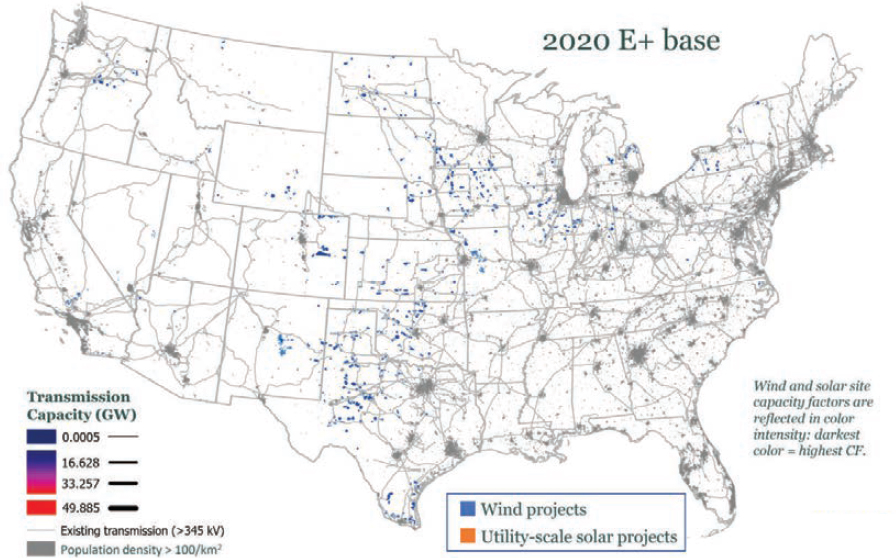
scenario (the “E+” scenario in Larson et al. [2021]15). Much of the additions to the transmission grid would be needed to bring new renewable electricity to centers of demand.
Timely expansion of transmission will make a significant difference in the total amount of generating capacity needed to serve demand and attain national decarbonization goals, as illustrated by the recent 2022 REPEAT Project Report:
[The] IRA could cut U.S. greenhouse gas emissions by roughly one billion tons per year in 2030 and reduce cumulative greenhouse gas emissions by 6.3 billion tons of CO2-equivalent over the decade (2023–2032). That outcome depends on more than doubling the historical pace of electricity transmission expansion over the last decade in order to interconnect new renewable resources at sufficient pace and meet growing demand from electric vehicles, heat pumps, and other electrification. . . . Failing to accelerate transmission expansion beyond the recent historical pace (~1%/year) increases 2030 U.S. greenhouse emissions. . . . Over 80% of the potential emissions reductions delivered by IRA in 2030 are lost if transmission expansion is constrained to 1%/year, and roughly 25% are lost if growth is limited to 1.5%/year. (Jenkins et al. 2022, pp. 3–4)
___________________
15 The E+ scenario “assumes aggressive end-use electrification, but energy-supply options are relatively unconstrained for minimizing total energy-system cost to meet the goal of net-zero emissions in 2050” (Larson et al. 2021, p. 9).
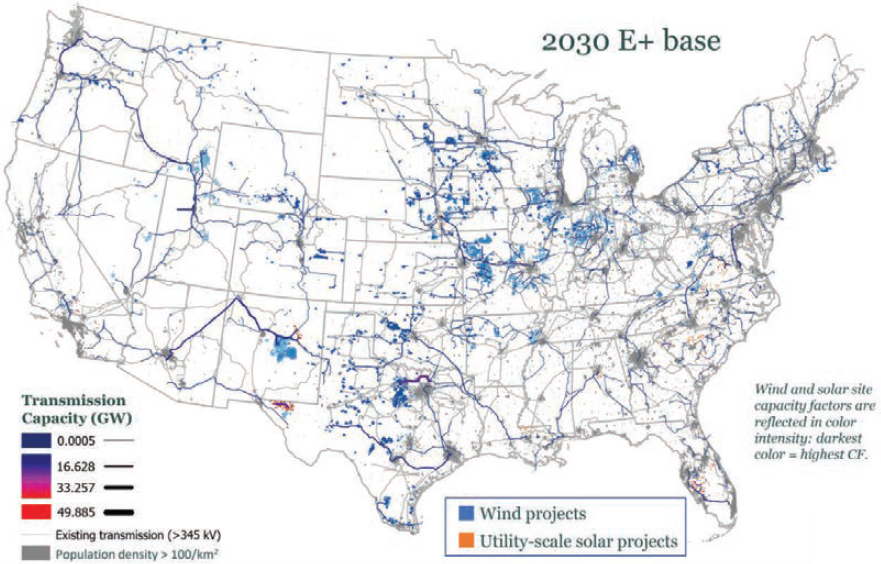
Siting long-distance transmission has historically been a fraught and difficult process involving stakeholders ranging from federal to local actors (NASEM 2021b). Historically, some of the most significant barriers—such as the “Five Ps” (Reed et al. 2021) of transmission planning, permitting, paying, participation, and process—are quite tenacious. These transmission issues are being addressed by actions at FERC16 and DOE, but—however well intended and critically important to decarbonization—each of those agency’s processes are time-consuming and their outcomes are uncertain. Many states and other stakeholders do not support expanded federal action to accelerate
___________________
16 In December 2022, FERC issued proposed rules to implement its newly expanded backstop siting authority under the IIJA (FERC 2022a). The proposed rules explain that under the Federal Power Act section 216(b)(1)(c) and the Proposed Rule, FERC’s backstop siting authority is triggered for a project: “(i) where the state does not have the authority to approve the siting of the facilities or to consider the interstate or interregional benefits expected to be achieved from the project; (ii) the applicant is not eligible for state siting approval because it does not serve end-use customers within the state; (iii) a state has not made a determination on an application within the specified timeframes; (iv) the state siting authority conditioned its approval such that the proposed facilities would not significantly reduce transmission capacity constraints or congestion in interstate commerce or in such a way that is not economically feasible; or (v) the state has denied an application” (Lipinski et al. 2022).
build-out of the interstate transmission system (Klein 2022; NARUC to FERC 2022). Differing positions on the siting of high-voltage transmission—like other infrastructure (Gelles 2022)—also arise from concerns about cost, local land-use, and environmental impacts versus regional benefits; different views about the need for new transmission in general and specific lines in particular; polarization and “not in my back yard” sentiments among members of the public; and other private versus public interests (Mohl 2021; NASEM 2021a,b; NASEM Committee 2022).
The amount of transmission capacity needed will depend on decarbonization policies and actions, with certain technologies (e.g., CCS and nuclear) presenting the potential to decrease inter-regional transmission build-out (Blanford and Bistline 2021), and with some modeling suggesting that the power sector can attain 100 percent clean energy by 2035 under a constrained technology and infrastructure scenario limiting transmission build-out (Denholm et al. 2022). DOE’s Transmission Facilitation Program now allows the agency to act as an “anchor tenant”—buying up to 50 percent of a planned line’s capacity rating for up to 40 years—for transmission projects supporting new lines of 1,000 MW and greater, or upgrading or replacing lines rated at least 500 MW (Grid Deployment Office 2022). An anchor tenant agreement from DOE provides a guaranteed customer, improving the financial case for transmission expansion, and allows for the sale of this contract to recover costs. Improving public engagement in transmission planning, siting, and permitting is broadly viewed as necessary (see Chapters 2, 5, and 13), but not necessarily sufficient to expansion of the grid. Benefit sharing is also essential, as is expansion of distributed energy resources and the modernization of local electric distribution systems to support them (see further discussion below). The committee reaffirms the importance of transmission expansion that was a finding and recommendation in its first report.
Finding 6-8: Expansion of the nation’s electric transmission system is a key enabler of and critical success factor for economical and accelerated decarbonization of the grid.
Finding 6-9: The nation needs a grand compromise on transmission—one that relies on a more inclusive and participatory set of processes to develop national-interest plans for needed expansion of the grid and that results in decisions that support actual expansion of the grid—as integral to accelerating decarbonization of the U.S. energy system. That compromise on transmission is also necessary to accomplish the public health, equity, affordability, reliability, and resilience benefits of the clean-energy transformation of the nation’s electric system.
Recommendation 6-2: Support the Expansion of the Transmission Grid. With regard to the siting of new high-voltage transmission infrastructure needed
to provide for an economical, reliable, resilient, and equitable transition to a net-zero electric system in regions where such transmission expansion is needed,
- The Federal Energy Regulatory Commission (FERC) should expeditiously update its transmission policy statements (i.e., its Notice of Proposed Rulemakings on transmission planning and cost allocation, and on interconnection of generating facilities).
-
The Department of Energy (DOE), FERC, the states, transmission companies, grid operators, and public stakeholders should expeditiously implement the new provisions of the Infrastructure Investment and Jobs Act (IIJA) and the Inflation Reduction Act (IRA), in conjunction with other aspects of Federal Power Act requirements and state statutes and regulations, so that
- DOE conducts its analyses and identifies corridors where transmission expansion is in the national interest and supports states’ goals for decarbonizing their electric systems;
- Transmission companies and/or, as appropriate, Regional Transmission Organization plan for projects to fulfill the need(s) identified in those and in other regional planning studies;
- DOE expeditiously disburses its $760 million under the IRA to fund states and local government’s technical assistance and financial support for communities’ meaningful participation;
- DOE collaborates with potential project applicants to use its “anchor tenant” authority to facilitate progress on high-value projects (in particular, interregional projects);
- DOE and the Department of the Interior (where appropriate on federal lands and offshore waters) conduct community impact analyses on transmission projects;
- Transmission providers work proactively with potentially affected and diverse stakeholders to discuss options for addressing routing for needed transmission infrastructure;
- State regulatory agencies establish expeditious procedural schedules to review and approve transmission project proposals and take into consideration both quantitative and qualitative information about the economic, reliability, resilience, decarbonization, regional interdependence, and other aspects of proposals; and
- FERC acts under its IIJA backstop siting authority to review and approve transmission projects that are in the national interest and do so on expedited procedural schedules.
Expansion of Regional Power Markets and Design to Accommodate Clean Energy Resources
In its first report, the committee previously identified the expansion of regional power markets as an important element of an efficient clean-energy transition of the electric industry. In conjunction with expansion of regional and inter-regional transmission systems and implementation of federal financial incentives for investment in clean energy, the expansion of wholesale markets will help with economical and reliable decarbonization of the electric system.
Researchers at RFF estimate that these new policies—including expansion of the interstate transmission grid—will produce billions in savings for consumers as well as cost-effective emissions reductions (Shawhan et al. 2022). Such outcomes result from efficient dispatch of a broad set of diverse power supplies and customers across broad regions, the ability of customers to gain access to green purchasing options, the leveraging of local distributed energy resources in conjunction with more centralized technology options, and the ability to achieve power-sector emissions caps at lowest cost.
States, too, have begun examining in earnest the potential implications of new, enhanced, expanded wholesale power markets. In December 2021, the Colorado Public Utilities Commission, for example, found significant consumer, environmental, and economic benefits of a Western RTO, which could reduce electricity costs for consumers by up to 5 percent annually while accelerating the state’s clean energy goals (CO PUC 2021). A 2023 study by NREL that synthesized other analyses of the potential benefits to California of expanded regional power-market cooperation found that both California and other states would realize cost savings, and reliability and common energy policy goals, with the size and character of these outcomes depending on the structure of regional cooperation approaches (Hurlbut et al. 2023). Another recent study found regional savings of $1.2 billion per year for a scenario in which all parts of the Western electrical interconnection join a West-Wide Enhanced Day-Ahead Market (Moyer and Ramirez 2022). Chang et al. (2020) observed that numerous studies have pointed to the role of regional markets in “reducing the cost of power, increasing reliability, reducing the need for new generation and transmission facilities, aiding the integration of renewable energy resources, and improving system balancing and operations.” Chen and Bardee (2020, pp. 1, 7) concluded that the benefits of “enhanced trading between utilities and resource sharing across broader regions can be substantial,” with greater net benefits potentially “derived from a platform transparently operated by an independent entity.”
Recommendation 6-3: Expand Regional Wholesale Power Markets Consistent with Decarbonization Objectives. To achieve the economic, environmental,
greenhouse gas emissions, and consumer benefits of a clean electricity transition:
- The Federal Energy Regulatory Commission (FERC) should work with Regional Transmission Organizations (RTOs) and regional energy imbalance markets to ensure that wholesale power markets in all parts of the country are designed to accommodate the shift to 100 percent clean power.
- Congress should provide incentives for transmission companies to join regional power systems administered by RTOs or participate in other wholesale market coordination approaches.
Design of Retail Electricity Rates and Pricing Options
In its first report, the committee also highlighted the role of the demand side of retail and wholesale electricity markets and systems in accomplishing electric-system decarbonization transitions that avoid massive build-outs of the supply side of the system that might otherwise be needed to meet the needs of an electrified economy. As explained in Chapters 7 and 9, electrification will produce economic efficiency, energy savings, and lower emissions, but it also enables opportunities to operate the electric grid devices in new and more efficient ways. For example, managing the timing of energy use of appliances or equipment (e.g., water heating, refrigeration and cooling, and EV batteries) can take advantage of the thermal and/or electrical storage capabilities of such resources and in so doing avoid installation of supply-side capacity. Designing electricity pricing and service options to encourage customers and suppliers of smart equipment, appliance-management applications, and other communications and control systems to deploy such resources can provide customer and system savings. In light of the many and very challenging issues in ratemaking and other utility policies and practices, doing so will require regulatory innovation and creativity beyond that shown in most utility rate cases at present—or even allowed in some jurisdictions (Madduri et al. 2022; Matisoff et al. 2020). Ensuring that electricity regulation provides both creative rate and service options to all customers while also ensuring basic electricity service rates for low-income customers is both technically possible (from a utility ratemaking point of view) and essential (to ensure equity as a core element of the decarbonization transition).
Recommendation 6-4: Provide Rate Options to Encourage Flexible Demand While Ensuring Affordable Electricity. Decision makers on utility rates
(i.e., state utility regulators and boards of publicly owned utilities) should direct utility management to:
- Prepare plans for the deployment of advanced meters for retail electricity customers where such do not already exist;
- Pilot and/or directly move to implementation of time-varying rate options (and where possible, dynamic rate options) for residential, commercial, and industrial customer classes, with communications strategies and control systems to enable flexible demand to meet customer and electric system needs cost-effectively; and
- Make sure that there are also options to ensure basic electricity service at affordable (and where possible, discounted) rates for low-income customers.
Deployment of Distributed Energy Resources on the Electric System
For decades, many large electricity customers have been able to take advantage of installing on their own premises various small-scale energy technologies (e.g., cogeneration systems) and energy management systems so as to manage their electricity usage and bills. In recent years, new cost-effective technology developments (such as rooftop solar, small-scale electricity storage systems, smart appliances, smart meters), combined with ratemaking and other regulatory tools (such as net energy metering, time-of-use rates, programmable controls on appliances, utility hosting studies showing locations where on-site generation can be added without utility distribution-system upgrades), have opened up the possibility for large and small customers to manage their electricity usage and in some cases inject power into the grid when it is not being used on site. These technologies present the opportunities to improve economic and equity outcomes for some consumers, but access to these benefits may also be limited owing to structural factors, including difficulties integrating these technologies with multi-family dwellings and/or in situations where renters may not control or capture the long-term benefits of investments in and on buildings. (See Chapter 5 of NASEM [2023] for further discussion on distributed generation and equity.) In the past decade or so, community solar farms and large-scale, individual solar projects that can be (and in many cases are) interconnected to the distributed system have experienced cost reductions so that these technologies have become relatively attractive for meeting renewable energy goals and for providing customers and the utility itself with more options. (DOE has a goal of seeing another 20 GW of community solar deployed commercially by 2025—for example, DOE [2021].)
Collectively known as “distributed energy resources” (DERs), such technologies have experienced notable growth, with 78 GW of capacity installed between 2017 through 2021, and the pace of DER deployment anticipated to increase in the near future (Hertz-Shargel 2022). They are seen in many states and localities as critical components of the technology option set needed for decarbonization and for meeting myriad other private objectives (e.g., customer bill savings, energy management, resilience from back-up supplies—which may enable improved energy justice outcomes; see Chapter 2) and public ones (e.g., renewable energy deployment; see Chapter 7). In many cases, DERs like energy efficiency, rooftop solar, and on-site battery storage can serve needs locally and avoid some generating and delivery capacity additions (although such outcomes are quite location-specific and in some cases the addition of DERs can cause additional investment in local distribution system capacity and capabilities above and beyond what might otherwise occur on the local grid; see further discussion below). It should be noted that increased amounts of DER on the electricity system motivates the need for improved planning and integration between wholesale and retail markets, as well as for planning across timescales (ranging from seconds to day-ahead). (See NASEM [2021b] for an in-depth discussion of these topics.)
The IRA provides consumer and corporate tax incentives for the installation of DERs, especially solar and storage systems. The IRA also supports expanded investment in energy efficiency and other weatherization measures, including for switching heating systems so as to use electricity. (See further discussion in Chapter 7.) Significantly, the IRA authorizes EPA to award $27 billion in funding from a new GHG Reduction Fund,17 a substantial portion of which may end up supporting the financing of various types of eligible projects, which could include DERs that reduce GHG emissions in
___________________
17 The IRA requires that the recipients of EPA’s awards of funding from the GHG Reduction Fund direct more than half of the funding to low-income and disadvantaged communities. EPA explains (in its October 21, 2022, Request for Information for the GHG Reduction Fund) that:
- Section 134(a)(1) of the IRA makes available “$7 billion to EPA to make competitive grants to States, municipalities, tribal governments, and eligible recipients . . . to provide subgrants, loans, or other forms of financial assistance as well as technical assistance to enable low-income and disadvantaged communities to deploy or benefit from zero-emission technologies, including distributed technologies on residential rooftops, and to carry out other greenhouse gas emission reduction activities” (p. 1).
- Section 134(a)(3) of the IRA “makes available $8 billion to EPA to make competitive grants to eligible recipients [i.e., certain non-profit institutions] for the provision of financial and technical assistance to projects that reduce or avoid greenhouse gas emissions and other forms of air pollution in low-income and disadvantaged communities” (p. 2).
- Section 134(a)(2) of the IRA “makes available $11.97 billion to EPA to make competitive grants to eligible recipients [i.e., certain non-profits] for the provision of financial and technical assistance to projects that reduce or avoid greenhouse gas emissions and other forms of air pollution” (p. 2). These funds may be applied in low-income and disadvantaged communities among other places.
low-income and disadvantaged communities (EPA 2022). Growing consumer interest in DERs, combined with new federal incentives and financing opportunities offered in the IRA and cost reductions in DER options, create opportunities for much-faster deployment as part of decarbonization efforts over the next decade. States, localities, and tribes that move expeditiously to help their constituents—especially those that otherwise lack the financial, informational, or other resources to install and use DERs—take advantage of such opportunities can achieve near-term emissions reductions and other economic and equity benefits. This can happen by using technical assistance to assist such constituents in ways that incorporate the practical needs of recipients (Brown 2023) and also to learn about and make use of lessons from other jurisdictions about the important roles of aligning various enabling policies such as utility rate design (described above) and local distribution system enhancements (described below) to facilitate the integration of DERs. Just as importantly as these direct benefits, accelerating adoption of DERs can also help invest households and communities in the clean energy transition and recognize and reap some of the rewards of the transition, both of which are important elements in building the social contract for the transition (see Chapters 2 and 5).
Recommendation 6-5: Support Equitable Deployment of Distributed Energy Resources (DERs). States, localities, and tribal governments should use the technical assistance, funding, and financing opportunities in the Inflation Reduction Act (especially, e.g., Environmental Protection Agency Greenhouse Gas Reduction Fund) and other programs (e.g., Department of Energy National Community Solar Partnership, state or utility-based net energy metering programs, community solar programs) to facilitate the deployment of distributed energy resources and to enable low-income and disadvantaged households and communities to have access and ownership opportunities for such DERs. Such technical assistance should take advantage of lessons learned about actions in other jurisdictions that facilitate DER deployment and access—especially in terms of the benefits that can arise if policies are well designed versus poorly designed. Such technical assistance should also be provided in ways that serve the practical needs of recipients.
Modernization of Local Electric Grids
The role of electric distribution systems has become increasingly important as part of innovative approaches to decarbonization. While local distribution systems have always played an essential role in connecting end-use electricity consumers to the
grid that provides them with around-the-clock access to reliable electricity supply, a decarbonized energy system amplifies the importance of a highly well-functioning local grid. Depending on the ways in which electrification occurs—for example, with substantial energy efficiency as part of building electrification; with rate designs that enable much-more flexible demand; with DERs located in particular in places that meet customer needs and provide grid services; with different pathways to electric vehicle charging buildout; with different levels or patterns of electrification in industry or heavy transport; with different levels of demand for firming hydrogen generation or powering CCS—the local distribution system will need very substantial investment and expansion.
At a minimum, the local grid will require different types of local-distribution system planning and operation than in the past, so that it accommodates two-way flows of power on circuits, more DER installations, more technologies to visualize and in some cases manage and control flows on the local system, and so forth. Although some of these activities can be supported by third-party actions and investments, much of these local-distribution system enhancements will need to be done by the local utility. Modernizing the local grid is an essential part of the transition to a decarbonized electric system (Gillis and Norris 2022), and additional research, analytics, other tools, and investment are needed to make the lower-voltage electric grid fit the needs of a highly electrified economy with much more complicated interactions with the electricity system (McDermont et al. 2022; NASEM 2021b). Investment in technical improvements to the local grid, its communication and control systems, and its delivery capacity are as essential to an equitable transition as are the DER technologies and bulk-power-system transformations more commonly identified as key to the needs of the future power system. This is especially true when local grid upgrades are piecemeal and follow customer investment in new electrical technologies (as is widely practiced currently) rather than flowing from a broad and participatory grid upgrade planning process designed to meet the long-term needs of decarbonization (see Chapters 2, 5, and 7). Attention to ensuring efficiencies in such investment and recovery of it from electricity users is also an essential piece of the decarbonization equation.
Recommendation 6-6: Support Planning, Public Participation, and Investment in Modernizing Local Grids. Decision makers on utility service provision (i.e., state utility regulators for jurisdictional investor-owned utilities and boards of cooperatives, municipal electric utilities and other publicly owned utilities) should direct their utilities to carry out planning, public participation, investment projects, rate proposals, and other actions necessary to modernize and ready local distribution systems for increased deployment of
distributed energy resources; for new loads driven by electrification actions in buildings, vehicles, and industry; for ensuring that all customers have equitable access to resilient and reliable power; and for operating and maintaining the local grid under much more complicated conditions than in the past. Such plans should anticipate the types of changes needed on the local distribution system to be ready as these changes occur, and to be equitable across customers, consistent with timely transitions to a net-zero economy. In jurisdictions where such decision makers lack existing authorities to require such changes, state legislatures should authorize and direct utilities to conduct such planning and grid modernization and to require the equitable recovery of costs related to them. Congress should continue to fund research and analysis on these topics through the Department of Energy.
Research, Development, Demonstration, and Deployment
Commercially available power technologies are already capable of decarbonizing electricity supply to a substantial degree. But with increasing and deep penetration of variable generating resources—which are unable to provide around-the-clock, dispatchable generation—reliable system operations will require a combination of on-demand generating technologies, storage that allows for flexible generation, long-duration storage to sustain supply during periods of high demand and/or constraints on wind and solar availability, flexible demand, and power-delivery technologies. Many of these resources—including flexible demand and transmission—are the subject of other recommendations. But other such resources—including advanced nuclear, hydrogen technologies, and long-duration storage—will require additional research, development, demonstration, and deployment (Kelly and Nelson 2023). As the committee concluded in its first report (and as recommended by the National Academies’ Committee on the Future of Electric Power in the United States [NASEM 2021b]), the federal government is uniquely positioned to provide such support. The committee reiterates its first report recommendation that Congress provide such funding as a high national priority.
Additionally, deployment of various technologies (including commercially ready technologies like wind, solar, and battery technologies) to advance net-zero energy transitions depend on critical minerals whose supply chains are subject to numerous domestic challenges and international risks (DOE 2022a; Kelly and Nelson 2023). These have been analyzed in detail by DOE, as part of executive branch efforts to identify and address technical, economic, and other policy drivers of such challenges (DOE 2022a).
Recommendation 6-7: Invest in Research, Development, and Demonstration (RD&D) of On-Demand Electric-Generating Technologies and Long-Duration Storage Technologies. Congress should continue to increase inflation-adjusted funding of RD&D for innovation on and commercialization of on-demand/firm electric generating technologies and long-duration storage technologies. Continued work in this area needs to support early-stage deployment, as well as research and analysis to ensure that commercial developments and applications, including siting of such technologies, addresses potential local adverse impacts to host communities. Additionally, Congress should support the Department of Energy’s work to secure resilient supply chains that will be critical in harnessing emissions outcomes and capturing the economic opportunity inherent in the energy-sector transition.
Table 6-1 summarizes all the recommendations in this chapter to support decarbonizing the electricity system.
SUMMARY OF RECOMMENDATIONS ON THE ESSENTIAL ROLE OF CLEAN ELECTRICITY
TABLE 6-1 Summary of Recommendations on the Essential Role of Clean Electricity
| Short-Form Recommendation | Actor(s) Responsible for Implementing Recommendation | Sector(s) Addressed by Recommendation | Objective(s) Addressed by Recommendation | Overarching Categories Addressed by Recommendation |
|---|---|---|---|---|
| 6-1: Adopt National Policy to Limit Power-Sector Greenhouse Gas Emissions | Congress |
|
|
A Broadened Policy Portfolio |
| 6-2: Support the Expansion of the Transmission Grid | Federal Energy Regulatory Commission (FERC), Department of Energy (DOE), states, transmission companies, public stakeholders, and Department of the Interior |
|
|
Siting and Permitting Reforms for Interstate Transmission |
| 6-3: Expand Regional Power Markets Consistent with Decarbonization Objectives | Congress, FERC, regional transmission organizations |
|
|
Siting and Permitting Reforms for Interstate Transmission |
| 6-4: Provide Rate Options to Encourage Flexible Demand While Ensuring Affordable Electricity | Decision makers on utility rates (i.e., state utility regulators for jurisdictional investor-owned utilities and boards of cooperatives, municipal electric utilities, and other publicly owned utilities) |
|
|
Ensuring Equity, Justice, Health, and Fairness of Impacts Siting and Permitting Reforms for Interstate Transmission |
| Short-Form Recommendation | Actor(s) Responsible for Implementing Recommendation | Sector(s) Addressed by Recommendation | Objective(s) Addressed by Recommendation | Overarching Categories Addressed by Recommendation |
|---|---|---|---|---|
| 6-5: Support Equitable Deployment of Distributed Energy Resources | States, localities, and tribal governments |
|
|
Ensuring Equity, Justice, Health, and Fairness of Impacts Siting and Permitting Reforms for Interstate Transmission |
| 6-6: Support Planning, Public Participation, and Investment in Modernizing Local Grids | Decision makers on utility service provision (i.e., state utility regulators for jurisdictional investor-owned utilities and boards of cooperatives, municipal electric utilities, and other publicly owned utilities) |
|
|
Ensuring Procedural Equity in Planning and Siting New Infrastructure and Programs Siting and Permitting Reforms for Interstate Transmission |
| 6-7: Invest in Research, Development, and Demonstration of On-Demand Electric-Generating Technologies and Long-Duration Storage Technologies | Congress |
|
|
Research, Development, and Demonstration Needs |
REFERENCES
Bergman, A., Burtraw, D., Richardson, N. 2022. “The Consequences of the Supreme Court’s West Virginia v. EPA Ruling for Environmental Regulation.” Resources. https://www.resources.org/common-resources/the-consequences-of-the-supreme-courts-west-virginia-v-epa-ruling-for-environmental-regulations.
BIL (Bipartisan Infrastructure Law) Summary. 2021. “Bipartisan Infrastructure Investment and Jobs Act Summary: A Road to Stronger Economic Growth.” https://www.cantwell.senate.gov/imo/media/doc/Infrastructure%20Investment%20and%20Jobs%20Act%20-%20Section%20by%20Section%20Summary.pdf.
Bistline, J., G. Blanford, M. Brown, D. Burtraw, M. Domeshek, J. Farbes, A. Fawcett, et al. 2023a. “Emissions and Energy Impacts of the Inflation Reduction Act.” Science 380(6652):1324–1327. https://doi.org/10.1126/science.adg3781.
Bistline, J., C. Raney, G. Blanford, and D. Young. 2023b. “Impacts of Inflationary Drivers and Updated Policies on U.S. Decarbonization and Technology Transitions.” #3002026229. Palo Alto, CA: EPRI. https://www.epri.com/research/products/000000003002026229.
Blanford, G., and J. Bistline. 2021. Powering Decarbonization: Strategies for Net-Zero CO2 Emissions. #3002020700. Palo Alto, CA: EPRI.
BPC (Bipartisan Policy Center). 2022a. “Inflation Reduction Act Summary: Energy and Climate Provisions.” https://bipartisanpolicy.org/blog/inflation-reduction-act-summary-energy-climate-provisions/#.
BPC. 2022b. “3 Reasons Why ‘Direct Pay’ Is Crucial for Clean Energy Tax Policy.” https://bipartisanpolicy.org/wp-content/uploads/2022/06/Energy-Direct-Pay-Infographic.pdf.
Brown, A. 2023 “An Open Letter to the Department of Energy: Enough with the Technical Assistance.” Utility Dive. January 30. https://www.utilitydive.com/news/an-open-letter-to-the-department-of-energy-enough-with-the-technical-assis/641491.
Brown, M.T. 2022. “Nearly a Quarter of the Operating U.S. Coal-Fired Fleet Scheduled to Retire by 2029.” https://www.eia.gov/todayinenergy/detail.php?id=54559.
C2ES. 2022. “U.S. State Climate Action Plans.” Center for Climate and Energy Solutions. https://www.c2es.org/document/climate-action-plans.
CBO (Congressional Budget Office). 2022. “Emissions of Carbon Dioxide in the Electric Power Sector.” December. https://www.cbo.gov/system/files/2022-12/58419-co2-emissions-elec-power.pdf.
CEBA (Clean Energy Buyers Alliance). 2023. https://cebuyers.org/programs/market-policy-innovations and https://cebuyers.org/deal-tracker.
Chang, J., J. Pfeifenberger, and J. Tsoukalis. 2019. “Potential Benefits of a Regional Wholesale Power Market to North Carolina’s Electricity Customers.” Brattle Group. https://www.brattle.com/wp-content/uploads/2021/05/16092_nc_wholesale_power_market_whitepaper_april_2019_final.pdf.
Chen, J., and Bardee, M. 2020. “How Voluntary Electricity Trading Can Help Efficiency in the Southeast.” https://www.rstreet.org/wp-content/uploads/2020/08/No.-201-Energy-Trade-in-the-Southeast.pdf.
CO PUC (Colorado Public Utilities Commission). 2021. “Colorado Transmission Coordination Act: Investigation of Wholesale Market Alternatives for the State of Colorado §§ 40-2.3-101 to 102, C.R.S.” https://www.dora.state.co.us/pls/efi/efi_p2_v2_demo.show_document?p_dms_document_id=961152.
Denholm, P., P. Brown, W. Cole, M. Trieu, B. Sergi, M. Brown, P. Jadun, et al. 2022. Examining Supply-Side Options to Achieve 100% Clean Electricity by 2035. Golden, CO: National Renewable Energy Laboratory. NREL/TP6A40-81644. https://www.nrel.gov/docs/fy22osti/81644.pdf.
DOE (Department of Energy). 2021. “DOE Sets 2025 Community Solar Target to Power 5 Million Homes.” https://www.energy.gov/articles/doe-sets-2025-community-solar-target-power-5-million-homes.
DOE. 2022a. “America’s Strategy to Secure the Supply Chain for a Robust Clean Energy Transition.” https://www.energy.gov/policy/articles/americas-strategy-secure-supply-chain-robust-clean-energy-transition.
DOE. 2022b. “Biden-Harris Administration Launches New Offices to Lower Energy Costs and Deploy Clean Power Nationwide.” https://www.energy.gov/articles/biden-harris-administration-launches-new-offices-lower-energy-costs-and-deploy-clean-power.
Domeshek, M., T. Bowen, C. Ivanova, K. Palmer, and B. Shobe. 2022. “State-Level Planning for Decarbonization: Critical Elements of State Action.” Resources for the Future. https://media.rff.org/documents/Report_22-10_v4.pdf.
DOS and EOP (Department of State and Executive Office of the President). 2021. “The Long-Term Strategy of the United States: Pathways to Net-Zero Greenhouse Gas Emissions by 2050.” Washington, DC. https://www.whitehouse.gov/wp-content/uploads/2021/10/US-Long-Term-Strategy.pdf.
EIA (Energy Information Administration). 2021. “U.S. Electricity Profile 2021.” https://www.eia.gov/electricity/state.
EIA. 2022a. “EIA Expects Renewables to Account for 22% of U.S. Electricity Generation in 2022.” Today in Energy, August 16. https://www.eia.gov/todayinenergy/detail.php?id=53459.
EIA. 2022b. “The U.S. Power Grid Added 15 GW of Generating Capacity in the First Half of 2022.” Today in Energy, August 3. https://www.eia.gov/todayinenergy/detail.php?id=53299.
EIA. 2023. “Total Energy: Monthly Energy Review.” https://www.eia.gov/totalenergy/data/monthly.
EPA (Environmental Protection Agency). 2022. “Request for Information: Greenhouse Gas Reduction Fund (RFI GHGRF).” EPA-HQ-OA-2022-0859. https://www.regulations.gov/docket/EPA-HQ-OA-2022-0859.
EPA. 2023. “EPA Proposes New Carbon Pollution Standards for Fossil Fuel-Fired Power Plants to Tackle the Climate Crisis and Protect Public Health.” https://www.epa.gov/newsreleases/epa-proposes-new-carbon-pollution-standards-fossil-fuel-fired-power-plants-tackle.
ESIG (Energy Systems Integration Group). 2021. “Transmission Planning for 100% Clean Electricity.” Energy Systems Integration Group. https://www.esig.energy/wp-content/uploads/2021/02/Transmission-Planning-White-Paper.pdf.
Eversheds Sutherland. 2022. “Inflation Reduction Act of 2022: The Energy Tax Provisions You Need to Know About.” https://us.eversheds-sutherland.com/NewsCommentary/Legal-Alerts/252759/Inflation-Reduction-Act-of-2022-The-energy-tax-provisions-you-need-to-know-about.
Ewing, J., and I. Penn. 2022. “Clean Energy Projects Surge After Climate Bill Passage.” The New York Times, September 7. https://www.nytimes.com/2022/09/07/business/energy-environment/clean-energy-climate-bill.html.
FERC (Federal Energy Regulatory Commission). 2021. “Advance Notice of Proposed Rulemaking: Building for the Future Through Electric Regional Transmission Planning and Cost Allocation and Generator Interconnection.” 176 FERC ¶ 61,024. Docket No. RM2-1-17-000. July 15. https://www.ferc.gov/news-events/news/advance-notice-proposed-rulemaking-building-future-through-electric-regional.
FERC. 2022a. “Applications for Permits to Site Interstate Electric Transmission Facilities.” Federal Energy Regulatory Commission. Proposed Rules. 181 FERC ¶ 61,205. Docket No. RM22-7-000. https://www.ferc.gov/media/e-1-rm22-7-000.
FERC. 2022b. “Explainer on the Transmission Notice of Proposed Rulemaking.” https://www.ferc.gov/explainer-transmission-notice-proposed-rulemaking.
Gelles, D. 2022. “The U.S. Will Need Thousands of Wind Farms. Will Small Towns Go Along?” The New York Times, December 30. https://www.nytimes.com/2022/12/30/climate/wind-farm-renewable-energy-fight.html?action=click&module=Well&pgtype=Homepage§ion=US%20News.
Gillis, J., and T. Norris. 2022. “Here Is What Is Really Strangling the Energy Transition.” The New York Times, December 17. https://www.nytimes.com/2022/12/16/opinion/solar-wind-electricity.html.
Goggin, M., R. Gramlich, and M. Skelly. 2021. “Transmission Projects Ready to Go: Plugging into America’s Untapped Renewable Resources.” Americans for a Clean Energy Grid. https://cleanenergygrid.org/wp-content/uploads/2019/04/Transmission-Projects-Ready-to-Go-Final.pdf.
Grid Deployment Office. 2022. “Transmission Facilitation Program (TFP).” Department of Energy. https://www.energy.gov/sites/default/files/2022-11/11.18.22%20TFP%20Fact%20Sheet_final.pdf.
Grid North Partners. 2022. “Grid North Partners Support MISO’s Long Range Transmission Plan.” https://gridnorthpartners.com/grid-north-partners-support-misos-long-range-transmission-plan.
Grid Strategies. 2023. “The Benefits of New Regional Transmission Planning Entities in the U.S. West and Southeast Regions.” https://cebi.org/wp-content/uploads/2023/02/CEBI-The-Benefits-of-New-Regional-Transmission-Planning-Entities-in-The-U.S.-West-And-Southeast-Regions.pdf.
Hertz-Shargel, B. 2022. “Distributed Energy Is Poised to Take Center Stage in 2022, But Policymakers and Regulators Must Step Up.” Utility Dive. https://www.utilitydive.com/news/distributed-energy-is-poised-to-take-center-stage-in-2022-but-policymakers/618331.
Howland, E. 2022. “Accelerating Renewable Energy Buildout Faces Big Hurdles, Even with Inflation Reduction Act: Developers.” Utility Dive, September 6. https://www.utilitydive.com/news/clean-energy-challenges-ira-inflation-reduction-wind-solar-storage/630988.
Hultman, N., C. Frisch, L. Clarke, K. Kennedy, P. Bodnar, P. Hansel, T. Cyrs, et al. 2019. Accelerating America’s Pledge: Going All-In to Build a Prosperous, Low-Carbon Economy for the United States. America’s Pledge Initiative on Climate Change. New York: Bloomberg Philanthropies with University of Maryland Center for Global Sustainability, Rocky Mountain Institute, and World Resources Institute. https://assets.bbhub.io/dotorg/sites/28/2019/12/Accelerating-Americas-Pledge.pdf.
Hultman, N., L. Clarke, C. Frisch, K. Kennedy, H. McJeon, T. Cyrs, P. Hansel, et al. 2020. “Fusing Subnational with National Climate Action Is Central to Decarbonization: The Case of the United States.” Nature Communications 11:5255. https://doi.org/10.1038/s41467-020-18903-w.
Hurlbut, D., Greenfogel, M. and Speetles, B. 2023. The Impacts on California of Expanded Regional Cooperation to Operate the Western Grid (Final Report). Golden, CO: National Renewable Energy Laboratory. NREL/TP-6A20-84848. https://www.nrel.gov/docs/fy23osti/84848.pdf.
Illinois Power Agency. 2021. Carbon Mitigation Credit Procurement Plan. https://ipa.illinois.gov/content/dam/soi/en/web/ipa/documents/ipa-final-cmc-procurement-plan-(-dec-16-2021).pdf.
Jenkins, J.D., J. Farbes, R. Jones, N. Patankar, and G. Schivley. 2022a. Electricity Transmission Is Key to Unlock the Full Potential of the Inflation Reduction Act. Princeton, NJ: REPEAT Project. https://repeatproject.org/docs/REPEAT_IRA_Transmission_2022-09-22.pdf.
Jenkins, J.D., E.N. Mayfield, J. Farbes, R. Jones, N. Patankar, Q. Xu, and G. Schivley. 2022b. Preliminary Report: The Climate and Energy Impacts of the Inflation Reduction Act of 2022. Princeton, NJ: REPEAT Project. https://repeatproject.org/docs/REPEAT_IRA_Prelminary_Report_2022-08-04.pdf.
Jenkins, J.D., G. Schively, E.N. Mayfield, N. Patankar, J. Farbes and R. Jones. 2023. Preview: Final REPEAT Project Findings on the Emissions Impacts of the Inflation Reduction Act and Infrastructure Investment and Jobs Act. Princeton, NJ: REPEAT Project.
Kelly, C., and Nelson, S. 2023. “Clear Path to a Clean Energy Future 2022.” https://static.clearpath.org/2023/02/CPCEF22-2-23.pdf.
King, B., H. Kolus, N. Dasari, E. Wimberger, W. Herndon, E. O’Rear, A. Rivera, J. Larsen, and K. Larsen. 2022. “Taking Stock 2022: US Greenhouse Gas Emissions Outlook in an Uncertain World.” Rhodium Group.
Klein, E. 2022. “All Biden Has to Do Now Is Change the Way We Live.” The New York Times, September 11. https://www.nytimes.com/2022/09/11/opinion/biden-climate-congress-infrastructure.html.
Larsen, J., B. King, H. Kolus, N. Dasari, G. Hiltbrand, and W. Herndon. 2022. “A Turning Point for US Climate Progress: Assessing the Climate and Clean Energy Provisions in the Inflation Reduction Act.” Rhodium Group. https://rhg.com/research/climate-clean-energy-inflation-reduction-act.
Larson, E., C. Greig, J. Jenkins, E. Mayfield, A. Pascale, C. Zhang, J. Drossman, et al. 2021. “Net-Zero America: Potential Pathways, Infrastructure, and Impacts, Final Report Summary.” https://netzeroamerica.princeton.edu/img/Princeton%20NZA%20FINAL%20REPORT%20SUMMARY%20(29Oct2021).pdf.
Lashof, D. 2023. “EPA’s Proposed Rules for Power Plant Emissions: 6 Key Questions, Answered.” https://www.wri.org/insights/epa-power-plant-rules-explained.
Levin, A., and Ennis. J. 2022. “Clean Electricity Tax Credits in the Inflation Reduction Act Will Reduce Emissions, Grow Jobs, and Lower Bills.” Issue Brief 22-09-2. Natural Resources Defense Council. https://www.nrdc.org/sites/default/files/clean-electricity-tax-credits-inflation-reduction-act-ib.pdf.
Lipinski, R.L., T. Ellis, J.B. Nelson, and J.D. Simon. 2022. “Backstop Siting: FERC Issues Notice of Proposed Rulemaking.” Van Ness Feldman (blog), December 22. https://www.vnf.com/backstop-siting-ferc-issues-notice-of-proposed-rulemaking.
Lopez, N. 2022. “Diablo Canyon: Nuke Plant a Step Closer to Staying Open Longer.” CalMatters, September 1. http://calmatters.org/environment/2022/09/diablo-canyon-legislature-california.
MA (Massachusetts) Department of Public Utilities. 2017. 220 CMR 23.00: St. 2016, c. 188, §12. https://www.mass.gov/regulations/220-CMR-2300-competitively-solicited-long-term-contracts-for-offshore-wind-energy.
Madduri, A., M. Foudeh, and P. Phillips. 2022. “Advanced Strategies for Demand Flexibility Management and Customer DER Compensation: Energy Division White Paper and Staff Proposal.” California Public Utilities Commission. https://www.cpuc.ca.gov/-/media/cpuc-website/divisions/energy-division/documents/demand-response/demand-response-workshops/advanced-der—demand-flexibility-management/ed-white-paper—advanced-strategies-for-demand-flexibility-management.pdf.
Mahajan, M., O. Ashmoore, J. Rissman, R. Orvis, and A. Gopal. 2022. “Update Inflation Reduction Act Modeling Using the Energy Policy Simulator.” Energy Innovation. https://energyinnovation.org/wp-content/uploads/2022/08/UpdatedInflation-Reduction-Act-Modeling-Using-the-Energy-Policy-Simulator.pdf.
Mai, T., P. Jadun, J. Logan, C. McMillan, M. Muratori, D. Steinberg, L. Vimmerstedt, R. Jones, B. Haley, and B. Nelson. 2018. Electrification Futures Study: Scenarios of Electric Technology Adoption and Power Consumption for the United States. Golden, CO: National Renewable Energy Laboratory. NREL/TP-6A20-71500. https://www.nrel.gov/docs/fy18osti/71500.pdf.
Matisoff, D., D. Beppler, G. Chan, and S. Carley. 2020. “A Review of Barriers in Implementing Dynamic Electricity Pricing to Achieve Cost-Causality.” Environmental Research Letters 15. https://iopscience.iop.org/article/10.1088/1748-9326/ab9a69/pdf.
McCarthy, E. 2022. “Pennsylvania Reaches the Regional Greenhouse Gas Initiative Starting Line.” Utility Dive.
McDermott, T.E., K. McKenna, M. Heleno, B.A. Bhatti, M. Emmanuel, and S.P. Forrester. 2022. “Distribution System Research Roadmap: Energy Efficiency and Renewable Energy.” Pacific Northwest National Laboratory, prepared for the Department of Energy. February 1. https://www.osti.gov/servlets/purl/1843579.
McGovern, J. 2022. “FERC Accepts PJM, NJBPU Agreement to Further Offshore Wind Goals.” PJM Inside Lines (blog), April 19.
McLaughlin, K., and L. Bird. 2021. “Implementing the Clean Energy Investments in US Bipartisan Infrastructure Law.” World Resources Institute. https://www.wri.org/insights/implementing-clean-energy-investments-us-bipartisan-infrastructure-law.
Micek, K. 2020. “Commodities 2021: States Racing to Set Goals Toward Net-Zero Emission, 100% Renewable Electricity.” S&P Global, December 24. https://www.spglobal.com/commodityinsights/en/market-insights/latest-news/electric-power/122420-commodities-2021-states-racing-to-set-goals-toward-net-zero-emission-100-renewable-electricity.
Mohl, B. 2021. “Maine Voters Tell Mass. to Stick Its Transmission Line.” Commonwealth Magazine. https://commonwealthmagazine.org/energy/maine-voters-tell-mass-to-stick-its-transmission-line.
Moyer, K., and Ramirez, D. 2022. “California EDAM Benefits Study: Estimating Savings for California and the West Under EDAM Market Scenarios.” Energy Strategies, prepared for the California ISO. November 4. http://www.caiso.com/Documents/Presentation-CAISO-Extended-Day-Ahead-Market-Benefits-Study.pdf.
NARUC to FERC (National Association of Regulatory Utility Commissioners to Federal Energy Regulatory Commission). 2022. “Comments of the National Association of Regulatory Utility Commissioners.” Federal Energy Regulatory Commission. Docket No. RM21-17-000. August 17. https://pubs.naruc.org/pub/F3AF556A-1866-DAAC-99FB-BFE2357A9443?_gl=1*1n13vec*_ga*MTE2OTkwMDYwNS4xNjcwOTM0OTI0*_ga_QLH1N3Q1NF*MTY3MDkzNDkyMy4xLjEuMTY3MDkzNDkzOS4wLjAuMA.
NASEM (National Academies of Sciences, Engineering, and Medicine). 2021a. Accelerating Decarbonization of the U.S. Energy System. Washington, DC: The National Academies Press. https://doi.org/10.17226/25932.
NASEM. 2021b. The Future of Electric Power in the United States. Washington, DC: The National Academies Press. https://doi.org/10.17226/25968.
NASEM. 2021c. “Recommended Policies for Reaching Net-Zero Carbon Emissions.” https://nap.nationalacademies.org/resource/25932/interactive/table/index.html#top.
NASEM. 2023. The Role of Net Metering in the Evolving Electricity System. Washington, DC: The National Academies Press. https://doi.org/10.17226/26704.
NASEM Committee. 2022. “Public Engagement Across the Transmission Development Lifecycle: from Planning to Permitting.” NASEM Committee on Accelerating Decarbonization of the U.S. Energy System. https://vimeo.com/757193592.
Parlapiano, A., and J. Tankersley. 2021. “What’s in Biden’s Infrastructure Plan?” The New York Times, March 31.
Pascale, A., and Jenkins, J.D. 2021. “Princeton’s Net-Zero America Study—Annex F: Integrated Transmission Line Mapping and Costing.” https://netzeroamerica.princeton.edu/the-report.
Pennsylvania DEP (Department of Environmental Protection). 2021. “Pennsylvania Climate Action Plan 2021: Strategies for government, business, agriculture, and community leaders—and all Pennsylvanians.” Pennsylvania DEP, ICF, Penn State University and Hamel Environmental Consulting. http://www.depgreenport.state.pa.us/elibrary/GetDocument?docId=3925177&DocName=2021%20PENNSYLVANIA%20CLIMATE%20ACTION%20PLAN.PDF%20%20%3cspan%20style%3D%22color:green%3b%22%3e%3c/span%3e%20%3cspan%20style%3D%22color:blue%3b%22%3e%28NEW%29%3c/span%3e%209/21/2023.
Penrod, E. 2022. “Corporate Clean Energy Procurement on Track for Another Record Year After Adding 11 GW in 2021.” Utility Dive. https://www.utilitydive.com/news/corporate-clean-energy-procurement-ceba-report/623926.
Peretzman, P. 2022. “Board of Public Utilities | New Jersey Advances Offshore Wind Transmission Proposal at Federal Energy Regulatory Commission.” Newsroom and Public Notices. https://www.nj.gov/bpu/newsroom/2022/approved/20220127.html.
Reed, L., L. Abrahams, A. Cohen, J. Majkut, B. Phillips, A. Place, and J. Prochnik. 2021. “Report: How Are We Going to Build All That Clean Energy Infrastructure?” Niskanen Center and Clean Air Task Force. August 24. https://www.niskanencenter.org/report-how-are-we-going-to-build-all-that-clean-energy-infrastructure.
RFF (Resources for the Future). 2022. “Climate Change and the Supreme Court: West Virginia v. EPA.” Resources for the Future. https://www.rff.org/events/rff-live/climate-change-and-the-supreme-court-west-virginia-v-epa.
RGGI (Regional Greenhouse Gas Initiative). n.d. “The Regional Greenhouse Gas Initiative: An Initiative of Eastern States of the US.” https://www.rggi.org/program-overview-and-design/elements. Accessed January 11, 2023.
Rivera, A., B. King, J. Larsen, and K. Larsen. 2023. “Preliminary US Greenhouse Gas Emissions Estimates for 2022.” Rhodium Group. January 10. https://rhg.com/research/us-greenhouse-gas-emissions-2022.
Roy, N., D. Burtraw, and K. Rennert. 2022. “Retail Electricity Rates Under the Inflation Reduction Act of 2022.” Resources for the Future Issue Brief 22-07. https://media.rff.org/documents/IB_22-07_HcKDycO.pdf.
Samaras, C. 2022. “Power Sector Carbon Index—2022 Q2 Update.” Power Sector Carbon Index. Scott Institute for Energy Innovation, Carnegie Mellon University. https://emissionsindex.org/news-events/power-sector-carboni-ndex-2022-q2-update.
SEC (Securities and Exchange Commission). 2022. “SEC Proposes Rule to Enhance and Standardize Climate-Related Disclosures for Investors.” https://www.sec.gov/news/press-release/2022-46.
SEPA (Smart Electric Power Alliance). 2023. “Utility Carbon Reduction Tracker.” Smart Electric Power Alliance. https://sepapower.org/utility-transformation-challenge/utility-carbon-reduction-tracker.
Schurle, A., and T. Roessler. 2022. “The Inflation Reduction Act: Key Provisions Regarding the ITC and PTC.” Foley and Lardner. https://www.foley.com/en/insights/publications/2022/08/inflation-reduction-act-key-provisions-itc-ptc.
Shawhan, D., S. Witkin, and C. Funke. 2022. “Pathways Toward Grid Decarbonization: Impacts and Opportunities for Energy Customers from Several US Decarbonization Approaches.” Resources for the Future. https://media.rff.org/documents/Shawhan_Pathways_II_final_pres.pdf.
Sidley. 2022. “Inflation Reduction Act: Overview of Energy-Related Tax Provisions—An Energy Transition ‘Game Changer.’” August 18. https://www.sidley.com/en/insights/newsupdates/2022/08/inflation-reduction-act-an-energy-transition-game-changer.
Steinberg, D.C., M. Brown, R. Wiser, P. Donohoo-Vallett, P. Gagnon, A. Hamilton, M. Mowers, C. Murphy, and A. Prasana. 2023. “Evaluating Impacts of the Inflation Reduction Act and Bipartisan Infrastructure Law on the U.S. Power System.” NREL. Technical Report NREL/TP-6A20-85242. https://www.nrel.gov/docs/fy23osti/85242.pdf.
Supreme Court of the United States. 2021. West Virginia et al. v. Environmental Protection Agency et al. https://www.supremecourt.gov/opinions/21pdf/20-1530_n758.pdf.
Tallackson, H., and S. Baldwin. 2022. “Implementing the Inflation Reduction Act: A Roadmap for Federal and State Buildings Policy.” Energy Innovation: Policy & Technology. https://energyinnovation.org/wp-content/uploads/2022/11/Implementing-The-Inflation-Reduction-Act-A-Roadmap-For-State-And-Federal-Buildings-Policy.pdf.
Trabish, H.K. 2021. “State, Federal Actions Show Growing Push for a Nuclear Role in Reaching Net Zero Emissions.” Utility Dive. September 28. https://www.utilitydive.com/news/state-federal-actions-show-growing-push-for-a-nuclear-role-in-reaching-net/606107.
White House. 2021a. “Executive Order on Tackling the Climate Crisis at Home and Abroad.” https://www.whitehouse.gov/briefing-room/presidential-actions/2021/01/27/executive-order-on-tackling-the-climate-crisis-at-home-and-abroad.
White House. 2021b. “President Biden Announces the Build Back Better Framework.” https://www.whitehouse.gov/briefing-room/statements-releases/2021/10/28/president-biden-announces-the-build-back-better-framework.
White House. 2021c. “President Biden Sets 2030 Greenhouse Gas Pollution Reduction Target Aimed at Creating Good-Paying Union Jobs and Securing U.S. Leadership on Clean Energy Technologies.” https://www.whitehouse.gov/briefing-room/statements-releases/2021/04/22/fact-sheet-president-biden-sets-2030-greenhouse-gas-pollution-reduction-target-aimed-at-creating-good-paying-union-jobs-and-securing-u-s-leadership-on-clean-energy-technologies.
Willson, M. 2022. “MISO Approves Large Grid Expansion, Paving Way for Renewables.” E&E News. July 26. https://www.eenews.net/articles/miso-approves-large-grid-expansion-paving-way-for-renewables.


















